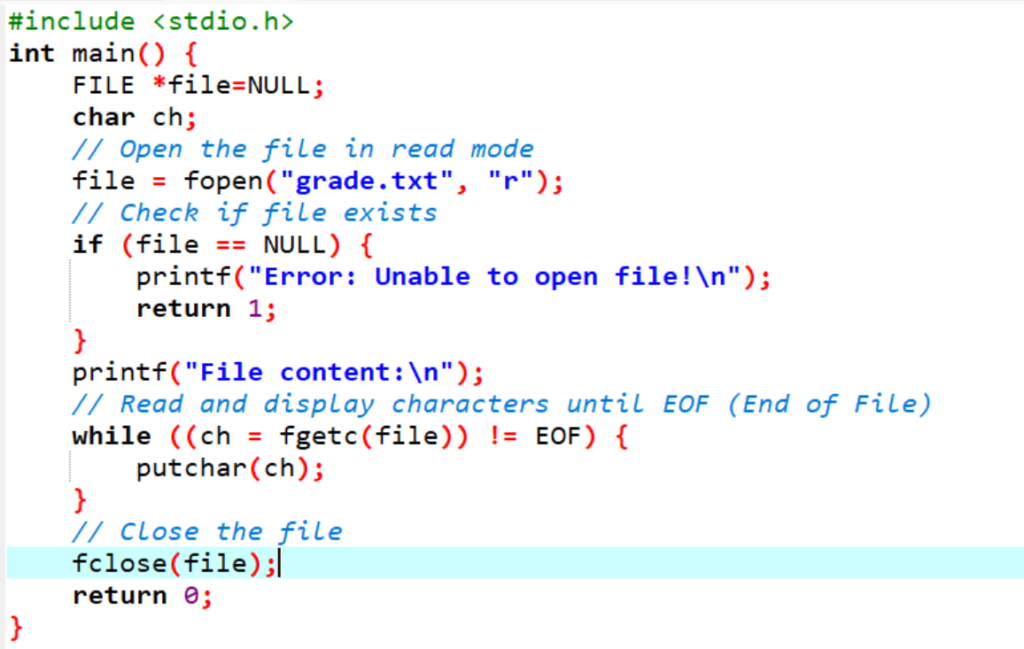Programming concept with C
Assignments
- Online Compiler
- Introduction of Programming Language
- Assembler, Compiler and Interpreter
- Syntax & Semantics
- Programming Designing Tools
- Features of Good Programme
- Unit2 History of C Program
- Basic Structure of C program
- Character Set, Token & Comments
- Variable
- Datatypes
- Type Conversion / Type Casting
- Operators
- Unit 6 Structure and Union
- Initializing, accessing member of structure
- Array of structure
- Pointer of structure
- Union
- Difference between structure and union
- Unit 7 Concept of File handling
- File Access Methods
- Functions of file handling: fopen(), fclose(),fflush(), freopen()
- Formatted input output
- direct input output
- Random File Access
- Error handling
- File operation
What is Program?
The program is the set of instructions that command the computer to perform a particular operation or a specific task.
- Instruction is a statement.
- A statement is an instruction to do only one task.
- A group of statements is composed together to form a program.
Unit 1 Introduction of Programming Language.
A programming language is a computer language that is used by programmers (developers) to communicate with computers. It is a set of instructions written in any specific language ( C, C++, Java, Python) to perform a specific task.
- A programming language is a language that allows people to write specific commands to be executed on a computer.
- A programming language is mainly used to develop desktop applications, websites, and mobile applications.
- Most commonly used Programming Language are Python, JAVA, C, C++, C#, RUBY, PHP … etc.
Types of Programming Language
- Low-level Language
- High Level Language
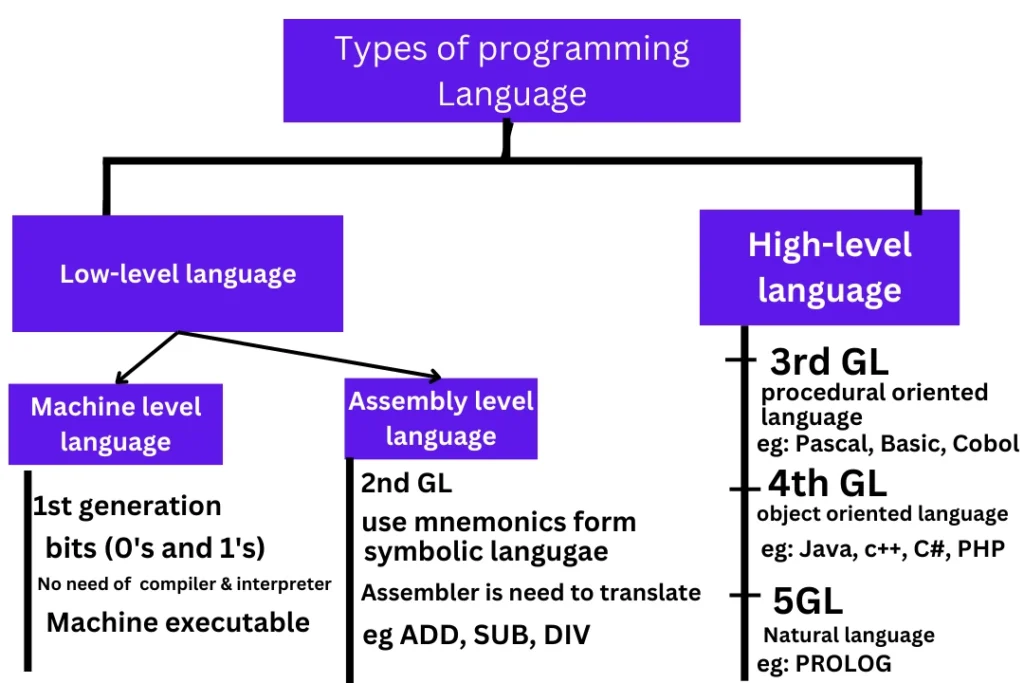
Language Translator
Translator is a software that translates or converts instructions written in assembly or high-level language (Source Code) into Machine language(Object Codes).
Why use Translator?
The program is developed in assembly or high level language for the easyness, understandable (Convenience) of the programmer, but the computer does not understand these statements directly, so translator is used which converts those statements in a computer execuable format.
Types of Translators
- Assembler
- Compiler
- Interpreter
Compiler: A Compiler is a translator which translates the complete high level program (Source Code) into the machine code (object code) at once if the program doesn’t contain syntax errors. Programming languages like C, C++, Java use the compiler.
Interpreter: An interpreter is a language translator which translates high-level language into the machine language at line at a time and executes the line of the program after it has been translated. It translates statements line by line.
Differences between Compiler and interpreter?
| Compiler | Interpreter |
|---|---|
| Compiler translates the whole program into object code at a time. | Interpreter Translates one line or single statement of a program into object code at a time. |
| Translating process is faster | Translating process is slower |
| It stores the converted machine code from your source code program on the disk. | It never stores the machine code at all on the disk. |
| The compiler shows the complete errors and warning messages at program compilation time. So it is not possible to run the program without fixing program errors. Doing debugging of the program is comparatively complex while working with a compiler | An interpreter reads the program line-by-line; it shows the error if present at that specific line. You must have to correct the error first to interpret the next line of the program. Debugging is comparatively easy while working with an Interpreter. |
| Examples of compiler based programming language are C, C++, Java, COBOL, Pascal, FORTRAN | Examples of Interpreter based programming are BASIC, C#, PHP |
Syntax
In a programming language, Syntax defines the rules that govern the structure and arrangement of keywords, symbols, and other elements. Syntax doesn’t have any relationship with the meaning of the statement; it is only associated with the grammar and structure of the programming language.
- A line of code is syntactically valid and correct if it follows all the rules of syntax.
- Syntax does not have to do anything with the meaning of the statement.
- Syntax errors are easy to catch.
- Syntax errors are encountered after the program has been executed
Semantics
Semantics refers to the meaning of the associated line of code and how they are executed in a programming language. semantics helps interpret what function the line of code/program is performing.
- If there is any semantic error and even when the statement has correct syntax, it wouldn’t perform the function that was intended for it to do. Thus, such errors are difficult to catch.
- Semantics are encountered at runtime.
Programming Design Tools
Program design Tools are the tools that are used to design a program before it actually developed. Program design tools are used by the developers. Some program design tools are: Algorith, Flow Charts, Pseudo Code, Data flow Diagram(DFD), Usecase Diagram… etc.
Algorithm: An algorithm is the sequence of steps that needs to be followed in order to acheive certain task. An algorithm is the fininte set of step by step set of statements that is used to solve a particular problem.
- It is written in simple human readable English Language.
An Algorithm should have the following properties:
- It should have an input.
- The steps mentioned in an algorithm can be executable by the computer
- Each and every instruction should be in a simple language.
- The number of steps should be finite.
- It should not depend on a particular computer language or computer.
- The algorithm should give an output after executing the finite numbers of steps.
Example of an algorithm:
1. Find the sum of two numbers.
step 1: START
Step2: Read the two numbers A and B.
Step3: Add the number A and B and store in S. or S=A+B.
Step4: Display D or Print D.
Step5: Stop.
2. Find the simple interest (SI).
Step1: Start.
Step2: Read the principal, rate, and time.
Step3: Multiply principal, rate and time.
Step4: Divide the product by 100 and store it in SI.
Step5: Print SI
Step6: END
3. Write an algorithm to Print 1 to 20 and also make flowchart.
Step1: Start.
Step2: Initialize X as 0,
Step3: Increment X by 1,
Step4: Print X,
Step5: If X is less then 20 then repeat from step 2 until X=20.
Step6: Stop.

Flowchart
A flowchart is a pictorial representation of an algorithm. Flowchart is a diagrammatic representation of sequence of logical steps of a program. Flowcharts use simple geometric shapes to depict processes and arrows to show relationships and process/data flow.
Flowchart to find a given number is odd or even.
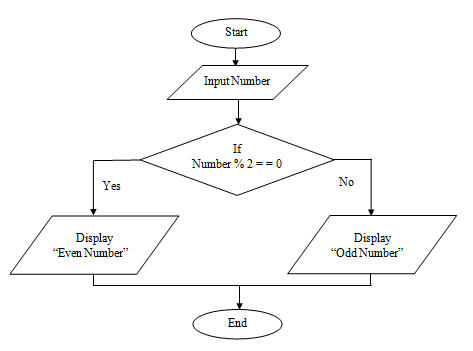

| Symbol | Symbol Name | Purpose |
|---|---|---|
 | Start/Stop | Used at the beginning and end of the algorithm to show start and end of the program. |
 | Process | Indicates processes like mathematical operations. |
 | Input/ Output | Used for denoting program inputs and outputs. |
 | Decision | Stands for decision statements in a program, where answer is usually Yes or No. |
 | Arrow | Shows relationships between different shapes. |
 | On-page Connector | Connects two or more parts of a flowchart, which are on the same page. |
 | Off-page Connector | Connects two parts of a flowchart which are spread over different pages. |
4. Determine Whether A Student Passed the Exam or Not:
Algorithm
- Step 1: Input grades of 4 courses M1, M2, M3 and M4,
- Step 2: Calculate the average grade with formula “Grade=(M1+M2+M3+M4)/4”
- Step 3: If the average grade is less than 60, print “FAIL”, else print “PASS”.
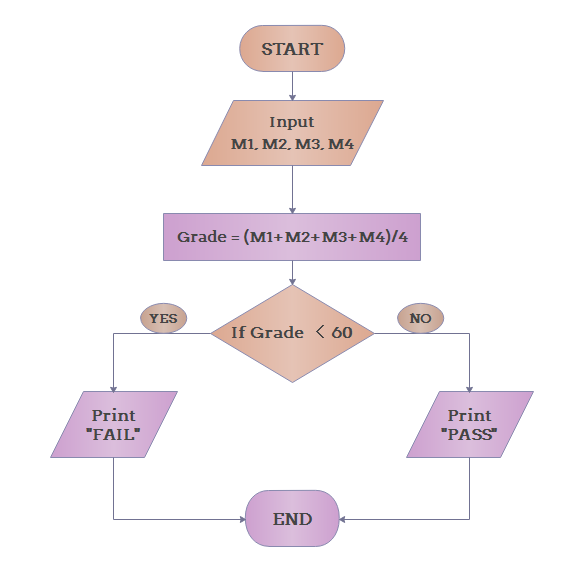
Differences between Algorithm and Flowchart?
| Algorithm | Flowchart |
|---|---|
| It is a procedure for solving problems. | It is a graphic representation of a process. |
| The process is shown in step-by-step instruction. | The process is shown in block-by-block information diagram. |
| It is complex and difficult to understand. | It is intuitive and easy to understand. |
| It is convenient to debug errors. | It is hard to debug errors. |
| The solution is showcased in natural language. | The solution is showcased in pictorial format |
| It is somewhat easier to solve complex problem. | It is hard to solve complex problem. |
| It costs more time to create an algorithm. | It costs less time to create a flowchart. |
Features of Good Programme.
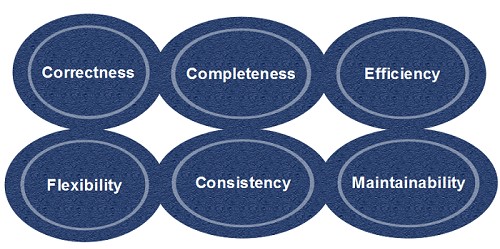
- Correctness: Program design should be correct as per requirement.
- Completeness: The design should have all components like data structures, modules, and external interfaces, etc.
- Efficiency: Resources should be used efficiently by the program.
- Flexibility: Able to modify on changing needs.
- Consistency: There should not be any inconsistency in the design.
- Maintainability: The design should be so simple so that it can be easily maintainable by other designers.
Portability
A program should be supported by many different computers. The program should compile and run smoothly on different platforms. Because of rapid development in hardware and software, platform change is a common phenomenon these days. So, portability is measured by how a software application can be transferred from one computer environment to another without failure. A program is said to be more portable if it is easily adopted on different computer systems. Subsequently, if a program is developed only for a particular platform, its life expectancy is seriously compromised.
Maintainability
It is the process of fixing program errors and improving the program. If a program is easy to read and understand, then its maintenance will be easier. It should also prevent unwanted work so that the maintenance cost in the future will be low. It should also have quality to easily meet new requirements. A maintainable software allows us to fix bugs quickly and easily, improve usability and performance, add new features, make changes to support multiple platforms, and so on.
Efficient
Program is said to be more efficient if it takes the least amount of memory and processing time and is easily converted to machine language. The algorithm should be more effective. Every program needs a certain amount of processing time and memory to process the instructions and data. The program efficiency is also high if it has a high speed during runtime execution of the program.
Reliable
The user’s actual needs will change from time-to-time, so the program is said to be reliable if it works smoothly in every version. It is measured as reliable if it gives the same performance in all simple to complex conditions.
Machine Independent
Program should be machine-independent. Program written on one system should be able to execute on many different types of computers without any changes. It is not system specific and provides more flexibility. An example of this would be Java.
Cost Effectiveness
Cost Effectiveness is the key to measure the program quality. The cost must be measured over the life of the program and must include both costs and human costs of producing these programs.
Flexible
The program should be written in such a manner that it allows one to add new features without changing the existing module. The majority of the projects are developed for a specific period, and they require modifications from time to time. It should always be ready to meet new requirements. Highly flexible software is always ready for a new world of possibilities.
Unit-2 Introduction to C
- C programming is a general-purpose, procedural programming language developed in 1972 by Dennis M. Ritchie at the Bell Telephone Laboratories to develop the UNIX operating system.
- The UNIX OS was totally written in C.
History of C
C programming language was developed in 1972 by Dennis Ritchie at bell laboratories of AT&T (American Telephone & Telegraph), located in the U.S.A. Dennis Ritchie is known as the founder of the c language. C was developed to overcome the problems of previous languages such as B, BCPL, etc.
Initially, C language was developed to be used in UNIX operating system. It inherits many features of previous languages such as B and BCPL.
| Language | Year | Developed By |
|---|---|---|
| Algol | 1960 | International Group |
| BCPL | 1967 | Martin Richard |
| B | 1970 | Ken Thompson |
| Traditional C | 1972 | Dennis Ritchie |
Today C is the most widely used and popular System Programming Language. Today’s most popular Linux OS and RDBMS MySQL have been written in C.
Structure of C Program
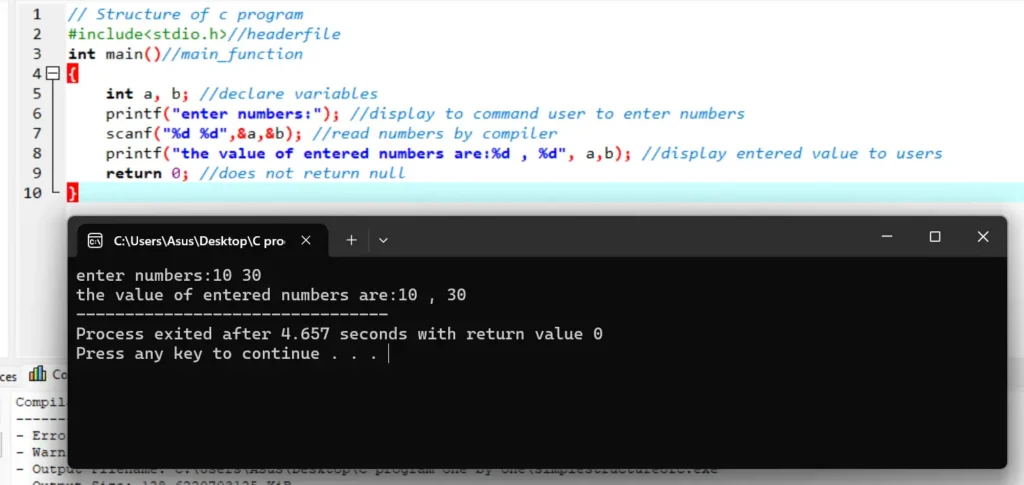
- Documentation (Documentation Section)
- Preprocessor Statements (Link Section)
- Definition Section
- Global Declarations Section
- Main functions section
- User-Defined Functions or Sub program functions
In C language, all these six sections together make up the Basic Structure of C Program
1. Documentation (Documentation Section)
Programmers write comments in the Documentation section to describe the program. The compiler ignores the comments and does not print them on the screen. Comments are used only to describe that program.
/* File Name -: Hello.c
Author Name -: Rajesh parajuli Founder of parajulirajesh.com.np
Date -: 12/09/2023
Description -: Basic Structure of C program */
//This is a single line comment2. Preprocessor Statements (Link Section)
Within the Link Section, we declare all the Header Files that are used in our program. From the link section, we instruct the compiler to link those header files from the system libraries, which we have declared in the link section in our program.
#include <stdio.h>
#include <conio.h>
#include <string.h>
#include <math.h>In addition to all these Header Files in the Link Section, there are a lot of Header Files which we can link in our program if needed.
3. Definition Section
The definition of Symbolic Constant is defined in this section, so this section is called Definition Section. Macros are used in this section.
#define PI 3.14
4. Global Declarations Section
Within the Global Declarations Section, we declare such variables which we can use anywhere in our program, and that variable is called Global Variables, we can use these variables in any function.
In the Global Declaration section, we also declare functions that we want to use anywhere in our program, and such functions are called Global Function.
int area (int x); //global function
int n; // global Variable5. Main functions section
Whenever we create a program in C language, there is one main() function in that program. The main () function starts with curly brackets and also ends with curly brackets. In the main () function, we write our statements.
The code we write inside the main() function consists of two parts, one Declaration Part and the other Execution Part. In the Declaration Part, we declare the variables that we have to use in the Execution Part, let’s understand this with an example.
int main (void)
{
int n = 15; // Declaration Part
printf ("n = %d", n); // Execution Part
return (0);
}6. User-Defined Functions or Sub Program Section
Declare all User-Defined Functions under this section.
int sum (int x, int y) { return x + y; }
What is the structure of C program syntax?
Any C Program can be divided into header, main() function, variable declaration, body, and return type of the program.
Basic Structure explaining with an example.
// Documentation
/**
* file: sum.c
* author: you
* description: program to find sum.
*/
// Link
#include <stdio.h>
// Definition
#define X 20
// Global Declaration
int sum(int y);
// Main() Function
int main(void)
{
int y = 55;
printf(“Sum: %d”, sum(y));
return 0;
}
// Subprogram
int sum(int y)
{
return y + X;
}
| Sections | Description |
|---|---|
| /** * file: sum.c * author: you * description: program to find sum. */ | It is the comment section and is part of the description section of the code. |
| #include<stdio.h> | Header file which is used for standard input-output. This is the preprocessor section. |
| #define X 20 | This is the definition section. It allows the use of constant X in the code. |
| int sum(int y) | This is the Global declaration section includes the function declaration that can be used anywhere in the program. |
| int main() | main() is the first function that is executed in the C program. |
| {…} | These curly braces mark the beginning and end of the main function. |
| printf(“Sum: %d”, sum(y)); | printf() function is used to print the sum on the screen. |
| return 0; | We have used int as the return type so we have to return 0 which states that the given program is free from the error and it can be exited successfully. |
| int sum(int y) { return y + X; } | This is the subprogram section. It includes the user-defined functions that are called in the main() function. |
Write a C program to implement subtraction by giving two numbers from user inputs.
//C Program To Subtract Two Numbers
#include<stdio.h>
int main()
{
int num1, num2, difference;
//Asking for input
printf(“Enter first number: “);
scanf(“%d”, &num1);
printf(“Enter second number: “);
scanf(“%d”, &num2);
difference = num1 – num2;
printf(“Difference of num1 and num2 is: %d”,difference);
return 0;
}
Character Set
As every language contains a set of characters used to construct words, statements, etc., C language also has a set of characters which include alphabets, digits, and special symbols. C language supports a total of 256 characters. Every character in C language has its equivalent ASCII (American Standard Code for Information Interchange) value.
Every C program contains statements. These statements are constructed using words and these words are constructed using characters from C character set. C language character set contains the following set of characters
- Alphabets
- Digits
- Special Symbols
C language supports all the alphabets from the English language. Lower and upper case letters together support 52 alphabets.
lower case letters – a to z
UPPER CASE LETTERS – A to Z
Digits: C language supports 10 digits which are used to construct numerical values in C language.
Digits – 0, 1, 2, 3, 4, 5, 6, 7, 8, 9
Special Symbols:
C language supports a rich set of special symbols that include symbols to perform mathematical operations, to check conditions, white spaces, backspaces, and other special symbols.
Special Symbols – ~ @ # $ % ^ & * ( ) _ – + = { } [ ] ; : ‘ ” / ? . > , < \ |
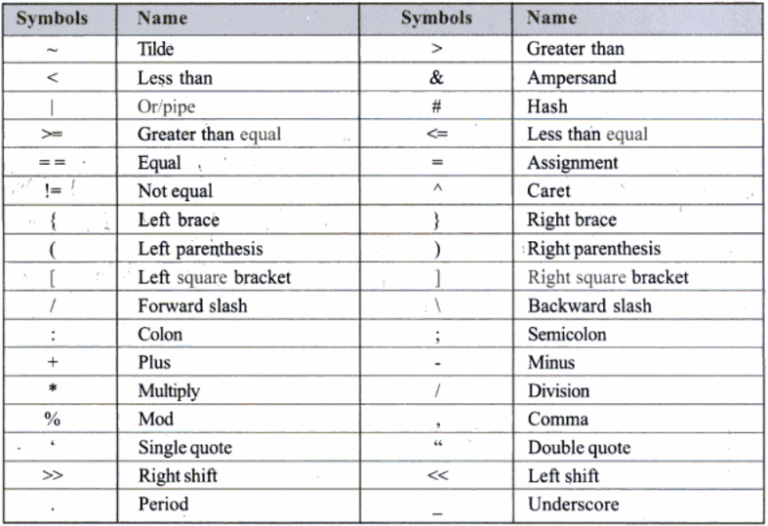
Token in C
A token is a smallest individual element of a program which is meaningful to the compiler. The compiler that breaks a program into the smallest units is called tokens and these tokens proceed to the different stages of the compilation.
- Tokens in C are building blocks which means a program can’t be created without tokens.
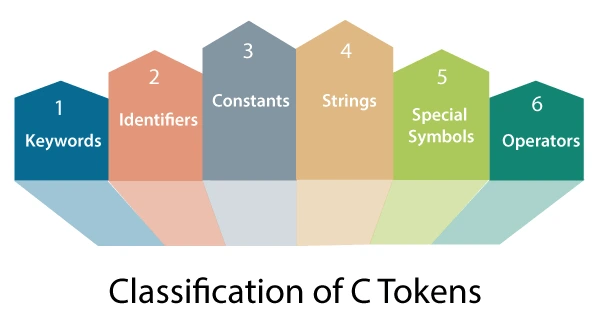
1.Keywords
Keywords are predefined, reserved words used in programming that have special meanings to the compiler. Keywords are part of the syntax and they cannot be used as an identifier.
As C is a case sensitive language, all keywords must be written in lowercase. Here is a list of all keywords allowed in ANSI C.
auto | double | int | struct |
break | else | long | switch |
case | enum | register | typedef |
char | extern | return | union |
continue | for | signed | void |
do | if | static | while |
default | goto | sizeof | volatile |
const | float | short | unsigned |
2.Identifiers
Identifiers in C are used for naming variables, functions, arrays, structures, etc. Identifiers in C are the user-defined words. It can be composed of uppercase letters, lowercase letters, underscore, or digits, but the starting letter should be either an underscore or an alphabet. Identifiers cannot be used as keywords. Rules for constructing identifiers in C are given below:
- An identifier can only have alphanumeric characters (a-z , A-Z , 0-9) (i.e. letters and digits) and underscore( _ ) symbol.
- Identifier names must be unique.
- The first character must be an alphabet or underscore.
- You cannot use a keyword as an identifier.
- Only the first thirty-one (31) characters are significant.
- It must not contain white spaces.
- Identifiers are case-sensitive.
For Example:
int cprogram;
Char Bicte_firstsemester;
here, int and Char is keywords and cprogram and Bicte_firstsemester is identifier.
3.Constants
The constants in C are the read-only variables whose values cannot be modified once they are declared in the C program. The type of constant can be an integer constant, a floating pointer constant, a string constant, or a character constant. In C language, the const keyword is used to define the constants.
What is a constant in C?
As the name suggests, a constant in C is a variable that cannot be modified once it is declared in the program. We can not make any change in the value of the constant variables after they are defined.
Syntax to Define Constant
const data_type var_name = value;
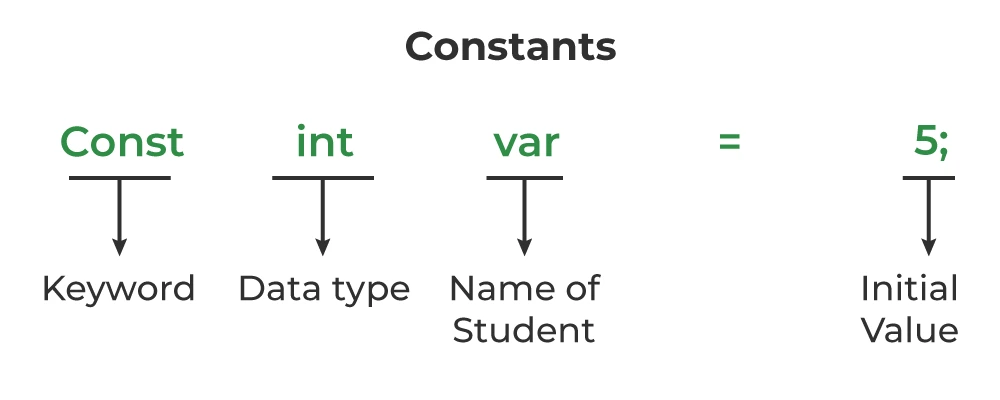
Types of Constants in C
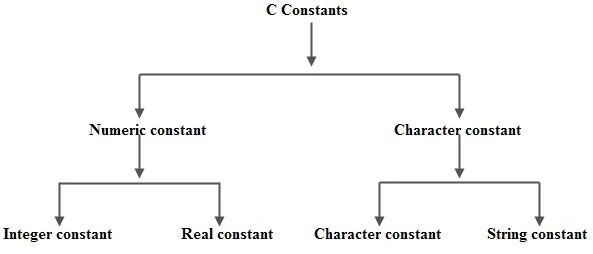
4.Strings
- Sequence of Characters is known as Strings.
- Every String is terminated by \0
- String Constant is a sequenced os 0 or more characters enclosed between double quotes ” ” is known as string constant e.g. “S”, “XYZ”, “123”, “hello world”
- All characters are converted into their corresponding ASCII value and then stored in memory as contiguous allocation.
- String Variable is the array of character type. For e.g. char[10];
char greeting[6] = {'H', 'e', 'l', 'l', 'o', '\0'};
If you follow the rule of array initialization then you can write the above statement as follows −
char greeting[] = "Hello";
#include <stdio.h>
int main () {
char greeting[6] = {'H', 'e', 'l', 'l', 'o', '\0'};
printf("Greeting message: %s\n", greeting );
return 0;
} #include <stdio.h>
int main()
{
char name[6];
printf(“Enter name: “);
scanf(“%s”, name);
printf(“Your name is %s.”, name);
return 0;
}
Like many other programming languages, strings in C are enclosed within double quotes(” “), whereas characters are enclosed within single quotes(‘ ‘). When the compiler finds a sequence of characters enclosed within the double quotation marks, it adds a null character (\0) at the end by default.
- Character arrays are used for declaring strings in C.
- The general syntax for declaring them is:
char variable[array_size];
5.Special Symbols
Special Symbols are symbols in C language that have special meaning and can not be used for any other purpose.
- Brackets[]: Opening and closing brackets are used as array element references. These indicate single and multidimensional subscripts.
- Parentheses(): These special symbols are used to indicate function calls and function parameters.
- Braces{}: These opening and ending curly braces mark the start and end of a block of code containing more than one executable statement.
- Comma (, ): It is used to separate more than one statement like for separating parameters in function calls.
- Colon(:): It is an operator that essentially invokes something called an initialization list.
- Semicolon(;): It is known as a statement terminator. It indicates the end of one logical entity. That’s why each individual statement must be ended with a semicolon.
- Asterisk (*): It is used to create a pointer variable and for the multiplication of variables.
- Assignment operator(=): It is used to assign values and for logical operation validation.
- Pre-processor (#): The preprocessor is a macro processor that is used automatically by the compiler to transform your program before actual compilation.
- Period (.): Used to access members of a structure or union.
- Tilde(~): Used as a destructor to free some space from memory.
The opening and closing square brackets represent single and multi-dimensional subscripts and they are used as array element reference for accessing array elements.
The opening and closing circular brackets are used for function calling and function declaration.
In C language, the curly braces are used to mark the start and end of a block of code containing executable logical statements.
printf(“Illustrating the use of curly braces!”);
}
Commas are used to separate variables or more than one statement just like separating function parameters in a function call.
It is a macro-processor that is automatically used by the compiler and denotes that we are using a header file.
#include<stdio.h> //For defining header-file
#define ll long
int main(){
printf(“Hello World!”);
}
Asterisk (*)
Asterisk symbols can be used for multiplication of variables and also for creating pointer variables. Example:
int main(){
int a = 20,b = 10;
int sum = a*b; //Use of asterisk in multiplication
int *ptr = &a;
//Pointer variable ptr pointing to address of integer variable a
}
Tilde (~)
It is used as a destructor to free some space from the memory.
int main(){
int n = 2;
printf(“Bitwise complement of %d: %d”, n, ~n);
//Bitwise complement of 2 can be found with the help of tilde operator and the result here is -3
}
Period (.)
It is used to access members of a structure or a union.
#include <stdio.h>
#include <string.h>
struct Person { //structure defined
int city_no; //members of structure
float salary;
}person1;
int main(){
person1.city_no = 100;
//accessing members of structure using period (.) operator
person1.salary = 200000;
printf(“City_Number: %d”,person1.city_no);
printf(“\nSalary: %.2f”,person1.salary);
return 0;
}
Colon (:)
It is used as a part of conditional operator ( ? : ) in C language.
Example:
int a = 10,b = 20,c;
c = (a < b) ? a : b;
//If a<b is true, then c will be assigned with the value of a else b
printf(“%d”, c);
Semicolon (;)
It is known as a statement terminator and thus, each logical statement of C language must be ended with a semi-colon.
Example:
int a=10; //Semi-colon is widely used in C programs to terminate a line
Assignment Operator (=)
It is used to assign values to a variable and is sometimes used for logical operation validation.
Example:
int a = 10, b = 20; //Assignment operator is used to assign some values to the variables
6.operators
Operators are symbols that are used to perform some operation or a set of operations on a variable or a set of variables. C has a set of operators to perform specific mathematical and logical computations on operands. C Supports a rich set of built-in Operators. Operators are used to perform operations on variables and values.
Example: Y= a+b
- =, + are operator
- a, b are operand
Types of Operator:
- on the basis of the number of operands required for an operator
- On the basis of utility or functions of an operator
1. On the Basis of number of operands required for an operator
Unary Operator: The operator which require only one operand are known as unary Operator. Examples: ++ (increment operator), — (decrement operator), X++, Y–
Binary Operators: The operators which require two operands are known as binary operators. For example: A+B, A-B, A*B, A/B etc.
Ternary Operators: The operators that require three operands are known as ternary operators. For Example: A ? B : C (this is also a condiotional operator).
2. On the Basis of Utility (or functions ) of an operator
- Arithmetic Operators
- Relational Operators
- Logical Operators
- Assignment Operators
- Increment and Decrement Operators
- Conditional Operators
- Bitwise Operators
- Special Operators
Arithmetic Operators
Arithmetic Operators are the type of operators in C that are used to perform mathematical operations in a C program. They can be used in programs to define expressions and mathematical formulas.
Operator | Name of the Operator | Arithmetic Operation | Syntax |
|---|---|---|---|
+ | Addition | Add two operands. | x + y |
– | Subtraction | Subtract the second operand from the first operand. | x – y |
* | Multiplication | Multiply two operands. | x * y |
/ | Division | Divide the first operand by the second operand. | x / y |
% | Modulus division | Calculate the remainder when the first operand is divided by the second operand. | x % y |
Relaional/ Comparison Operators
A relational operator checks the relationship between two operands. If the relation is true, it returns 1; if the relation is false, it returns value 0.
| Operator | Name | Example | Result |
|---|---|---|---|
| == | Equal to | x == y | Returns 1 if the values are equal |
| != | Not equal | x != y | Returns 1 if the values are not equal |
| > | Greater than | x > y | Returns 1 if the first value is greater than the second value |
| < | Less than | x < y | Returns 1 if the first value is less than the second value |
| >= | Greater than or equal to | x >= y | Returns 1 if the first value is greater than, or equal to, the second value |
| <= | Less than or equal to | x <= y | Returns 1 if the first value is less than, or equal to, the second value |
Logical operators
Logical Operators are used to compare or evaluate logical and relational expressions. The operands of logical operators must be either Boolean value (1 or 0) or expressions that produces Boolean value. The Output of these operators is always either 1 true or 0 False. The logical Operators supported in C are :
- && logical AND : it produces true if each operand is true otherwise it produces false.
- || Logical OR : it produces true when any of the conditions is true.
- ! Logical NOT- it reverse to the operand.
Write a program to illustrate the output of logical operators.
#include<stdio.h>
#include<conio.h>
int main()
{
int a=10, b=5, c=40;
printf(“a<b && a<c is %d\n”, (a<b && a<c));
printf(“a>b && b>c is %d\n”, (a>b && b<c));
printf(“a<b || a<c is %d\n”, (a<b || a<c));
printf(“a>b || b<c is %d\n”, (a>b || b<c));
printf(“a>c || b>c is %d\n”, (a>c || b>c));
Printf(“not operator “, a!b);
getch();
return 0;
}
Assignment operators
Assignment Operators are also binary operators and they are used to assign result of an expression to a variable. The mostly used assignment operator is ‘=’. There are other shorthand assignment operators supported by C. They are +=, -=, *=, /+ and %=. These Operators are also known as arithmetic assignment operators.
+= Addition Assignment (a+=b, means a=a+b) assign sum of a and b to a.
-= Subtraction Assignment ( a-=b, means a=a-b) assign subtraction of a and b to a)
*= Multiplication Assignment (a*=b, means a=a*b) assign multiplication of a and b to a)
/= Division Assignment (a/=b, means a=a/b) assign division of a and b to a)
%= Remainder Assignment (a%=b, means a=a%b) assign remainder of a divisible by b to a)
Demostrate the assignment operator in c program
#include<stdio.h>
#include<conio.h>
int main()
{
int a=10, b=5;
b+=a; //b=b+a
printf(“b=%d”, b);
getch();
return 0;
}
Output:
b=15
Increment and decrement operators
The increment operator is used to increase the value of an operand by 1; and the decrement operator is used to decrease the value of an operand by 1. They take one operand, so called unary operator. The syntax for the operator is:
- ++ variable
- variable++
- –variable
- variable++
#include <stdio.h>
int main() {
int x = 10;
printf(“Initial value of x: %d\n”, x);
x++; // Increment
printf(“After increment (x++): %d\n”, x);
x–; // Decrement
printf(“After decrement (x–): %d\n”, x);
return 0;
}
Conditional Operators
The Operator named “?:” is known as conditional Operator. It takes three operands. Thus, it is also called ternary operator. The syntax is :
value= expression ? expression2: expression3
working principal
- If(expression 1)
- variable = expression2;
- else
- variable = expression3;
Bitwise Operator
The bitwise operators are the operators used to perform the operations on the data at the bit-level. When we perform the bitwise operations, then it is also known as bit-level programming. It consists of two digits, either 0 or 1. It is mainly used in numerical computations to make the calculations faster. It can be used only integer type values not float, double etc.
We have different types of bitwise operators in the C programming language. The following is the list of the bitwise operators:
| Operator | Meaning of operator |
|---|---|
| & | Bitwise AND operator |
| | | Bitwise OR operator |
| ^ | Bitwise exclusive OR operator |
| ~ | One’s complement operator (unary operator) |
| << | Left shift operator |
| >> | Right shift operator |
Let’s look at the truth table of the bitwise operators.
| X | Y | X&Y | X|Y | X^Y |
|---|---|---|---|---|
| 0 | 0 | 0 | 0 | 0 |
| 0 | 1 | 0 | 1 | 1 |
| 1 | 0 | 0 | 1 | 1 |
| 1 | 1 | 1 | 1 | 0 |
Bitwise exclusive operator gives 0 if both corresponding values are same. if both corresponding vales are not same , it gives 1.
Write a program to demostrate bitwise operator.
#include<stdio.h>
int main()
{
int a=7,b=14;
printf(“Bitwise AND %d\n”, a&b);
printf(“Bitwise OR %d\n”, a|b);
printf(“Bitwise XOR %d\n”, a^b);
return 0;
}
Output:
Bitwise AND 6
Bitwise OR 15
Bitwise XOR 9
Left Shift Operator
The left shift operator is a type of Bitwise shift operator, which performs operations on the binary bits. It is a binary operator that requires two operands to shift or move the position of the bits to the left side and add zeroes to the empty space created at the right side after shifting the bits.
Bitwise Left shift operator is used to shift the binary sequence to the left side by specified position.
Example
Let’s take a number 14.
Binary representation of 14 is 00001110 (for the sake of clarity let’s write it using 8 bit)
14 = (00001110) 2
Then 14 << 1 will shift the binary sequence 1 position to the left side.
Like,
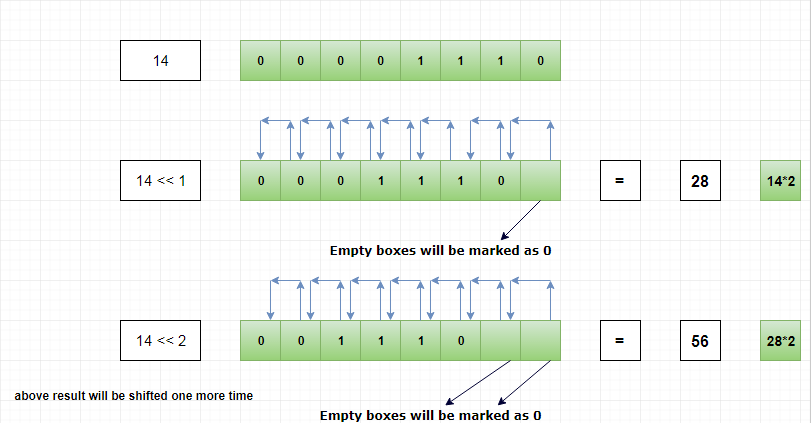
- #include <stdio.h>
- int main ()
- {
- // declare local variable
- int num;
- printf (” Enter a positive number: “);
- scanf (” %d”, &num);
- // use left shift operator to shift the bits
- num = (num << 2); // It shifts two bits at the left side
- printf (” \n After shifting the binary bits to the left side. “);
- printf (” \n The new value of the variable num = %d”, num);
- return 0;
- }
Enter a positive number: 14 After shifting the binary bits to the left side. The new value of the variable num = 56
In general, if we shift a number by n position to left, the output will be number * (2n).
Right Shift Operator
The right shift operator is a type of bitwise shift operator used to move the bits at the right side, and it is represented as the double (>>) arrow symbol. Like the Left shift operator, the Right shift operator also requires two operands to shift the bits at the right side and then insert the zeroes at the empty space created at the left side after shifting the bits.
Bitwise Right shift operator >> is used to shift the binary sequence to right side by specified position.
Example
Let’s take a number 14.
Binary representation of 14 is 00001110 (for the sake of clarity let’s write it using 8 bit)
14 = (00001110) 2
Then 14 >> 1 will shift the binary sequence by 1 position to the right side.
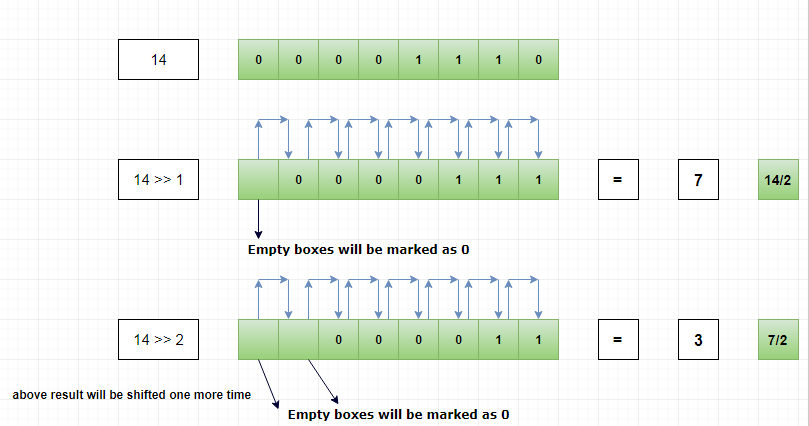
In general, if we shift a number by n times to right, the output will be number / (2n) .
- #include <stdio.h>
- int main ()
- {
- // declare local variable
- int num;
- printf (” Enter a positive number: “);
- scanf (” %d”, &num);
- // use right shift operator to shift the bits
- num = (num >> 2); // It shifts two bits at the right side
- printf (” \n After shifting the binary bits to the right side. “);
- printf (” \n The new value of the variable num = %d”, num);
- return 0;
- }
Output:
Enter a positive number: 14 After shifting the binary bits to the right side. The new value of the variable num = 3
Datatypes
Datatypes refers to the types of data.
Category | Data Type | Format Specifier | Size (Bytes) | Range | Description |
Primitive | char | %c | 1 | -128 to 127 (signed) / 0 to 255 (unsigned) | Stores a single character. |
| signed char | %c | 1 | -128 to 127 | Stores a signed character. |
| unsigned char | %c | 1 | 0 to 255 | Stores an unsigned character. |
| int | %d, %i | 2 or 4 | -32,768 to 32,767 (2-byte) / -2,147,483,648 to 2,147,483,647 (4-byte) | Stores integers (whole numbers). |
| unsigned int | %u | 2 or 4 | 0 to 65,535 (2-byte) / 0 to 4,294,967,295 (4-byte) | Stores non-negative integers. |
| short int | %hd | 2 | -32,768 to 32,767 | Stores small integer values. |
unsigned short int | %hu | 2 | 0 to 65,535 | Stores small unsigned integers. | |
| long int | %ld | 4 or 8 | -2,147,483,648 to 2,147,483,647 (4-byte) / -9,223,372,036,854,775,808 to 9,223,372,036,854,775,807 (8-byte) | Stores long integers. |
| unsigned long int | %lu | 4 or 8 | 0 to 4,294,967,295 (4-byte) / 0 to 18,446,744,073,709,551,615 (8-byte) | Stores long unsigned integers. |
| long long int | %lld | 8 | -9,223,372,036,854,775,808 to 9,223,372,036,854,775,807 | Stores very large integers. |
| unsigned long long int | %llu | 8 | 0 to 18,446,744,073,709,551,615 | Stores very large unsigned integers. |
| float | %f | 4 | 3.4E-38 to 3.4E+38 | Stores single precision floating-point numbers. |
| double | %lf | 8 | 1.7E-308 to 1.7E+308 | Stores double precision floating-point numbers. |
| long double | %Lf | 10, 12, or 16 | 3.4E-4932 to 1.1E+4932 | Stores extended precision floating-point numbers. |
| void | N/A | 0 | N/A | Represents no value or an unknown type. |
Derived | Array | N/A | Depends | Depends on the type and number of elements | A collection of elements of the same type. |
| Pointer | %p | 4 or 8 | Depends on the system architecture | Stores the memory address of another variable. |
User-Defined | struct | N/A | Depends | Depends on the structure members | A collection of variables of different data types under one name. |
| union | N/A | Depends | Depends on the largest member | Shares memory among its members, with only one member being used at a time. |
| enum | %d | 4 | Based on the integer values assigned to constants | Represents a set of named integer constants. |
Variable
Variable is a container that holds the value of any kind of data type. It is a case sensitive in c program. It is an identifier which store the value and reserved some memory space for data of any type.
Syntax:
data_type variable_name=value;
Rules for defining variable
- A variable can have alphabets, digits, and underscore.
- A variable name can start with the alphabet, and underscore only. It can’t start with a digit.
- No whitespace is allowed within the variable name.
- A variable name must not be any reserved word or keyword, e.g. int, float, etc.
5 helloworld b 12.500000 19.990000
Datatypes List
| Data Type | Size | Description |
|---|---|---|
byte | 1 byte | Stores whole numbers from -128 to 127 |
short | 2 bytes | Stores whole numbers from -32,768 to 32,767 |
int | 4 bytes | Stores whole numbers from -2,147,483,648 to 2,147,483,647 |
long | 8 bytes | Stores whole numbers from -9,223,372,036,854,775,808 to 9,223,372,036,854,775,807 |
float | 4 bytes | Stores fractional numbers. Sufficient for storing 6 to 7 decimal digits |
double | 8 bytes | Stores fractional numbers. Sufficient for storing 15 decimal digits |
boolean | 1 bit | Stores true or false values |
char | 2 bytes | Stores a single character/letter or ASCII values |
Type Casting / Type Conversion
Type conversion is the way of converting a datatype of one variable to another datatype.
Types of type conversion:
- Implicit type conversion- conversion is done by the compiler and there is no loss of information. It is automatic type conversion.
- Explicit type conversion- conversion is done by the programmer and there will be loss of information.
 This process is also called type casting and it is user-defined. Here the user can typecast the result to make it of a particular data type
This process is also called type casting and it is user-defined. Here the user can typecast the result to make it of a particular data type
Syntax:
(type) expression
Example:
float f = 10.5;
int num = (int)f; // Explicit typecasting (float to int)
int y=5;
int sum;
Control Statements in c
Control Statements control the flow of execution of the statements of a program. The various types of Control statements are :
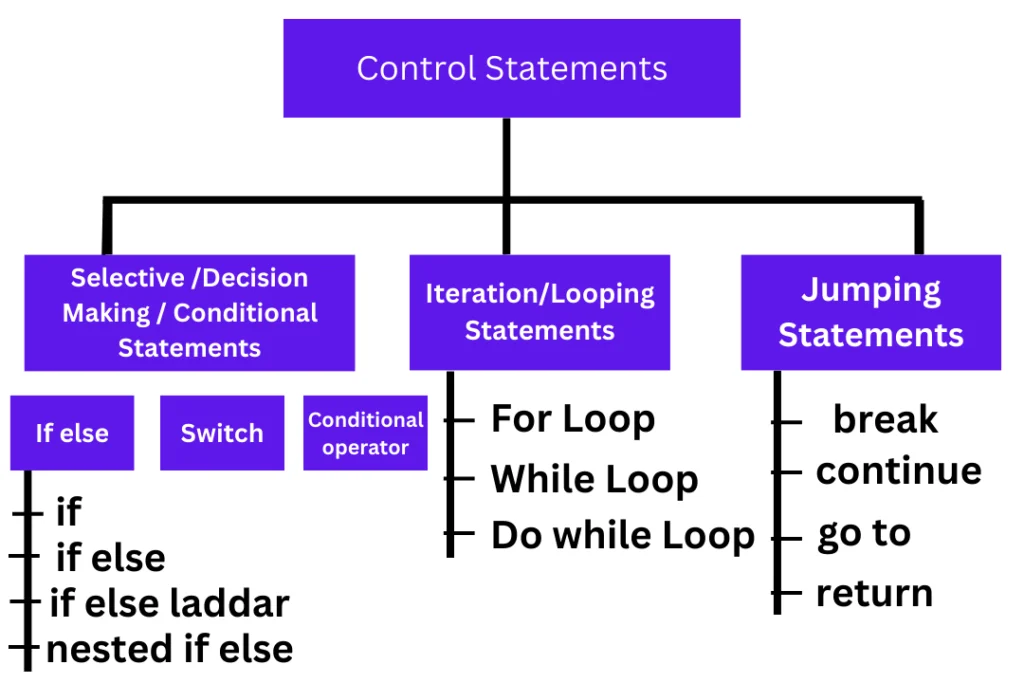
In conditional control , the execution of statements depends upon the condition-test. If the condition evaluates to true, then a set of statements is executed otherwise another set of statements is followed. This control is also called Decision Control or selective control statement because it helps in making decision about which set of statements is to be executed.
If statement: This is the most simple form of decision control statement. In this form, a set of statements are executed only if the condition given with if evaluates to true.
Syntax:
if(condition)
{
//if block of Statements executed if the given if condition is true ;
}
If else Statement: This is a bi-directional control statement. This statement is used to test a condition and take one of the two possible actions. If the condition evaluates to true then one statement (or block of statements) is executed otherwise other statement (or block of statements) is executed.
Syntax:
if(expression)
{
//code to be executed if condition is true
}
else
{
//code to be executed if condition is false
}
//executed outer statements;
If else ladder statements(if-else-if):
The if-else-if ladder statement is an extension to the if-else statement. It is used in the scenario where there are multiple cases to be performed for different conditions. In if-else-if ladder statement, if a condition is true then the statements defined in the if block will be executed, otherwise if some other condition is true then the statements defined in the else-if block will be executed, at the last if none of the condition is true then the statements defined in the else block will be executed. There are multiple else-if blocks possib
Syntax:
if(condition1)
{
//code to be executed if condition1 is true
}
else if(condition2)
{
//code to be executed if condition2 is true
}
else if(condition3)
{
//code to be executed if condition3 is true
}
…
else
{
//code to be executed if all the conditions are false
}
//executed outer statements if it is there;
Nested if else: Nested if else statement is a control statement where both if else statement is there with having another if else statement inside it.
Syntax of nested if else:
if (condition1){
if (condition2)
stmt1;
else
stmt2;
}
else {
if (condition3)
stmt3;
else
stmt4;
}
Q. Find greatest number among three numbers using if statement.
#include <stdio.h>
int main() {
int n1, n2, n3;
printf(“Enter three different numbers: “);
scanf(“%d %d %d”, &n1, &n2, &n3);
// if n1 is greater than both n2 and n3, n1 is the largest
if (n1 >= n2 && n1 >= n3)
printf(“%d is the largest number.”, n1);
// if n2 is greater than both n1 and n3, n2 is the largest
if (n2 >= n1 && n2 >= n3)
printf(“%d is the largest number.”, n2);
// if n3 is greater than both n1 and n2, n3 is the largest
if (n3 >= n1 && n3 >= n2)
printf(“%d is the largest number.”, n3);
return 0;
}
Q. Find greatest number among three numbers using if else laddar statement.
#include <stdio.h>
int main() {
int n1, n2, n3;
printf(“Enter three numbers: “);
scanf(“%d %d %d”, &n1, &n2, &n3);
// if n1 is greater than both n2 and n3, n1 is the largest
if (n1 >= n2 && n1 >= n3)
printf(“%d is the largest number.”, n1);
// if n2 is greater than both n1 and n3, n2 is the largest
else if (n2 >= n1 && n2 >= n3)
printf(“%d is the largest number.”, n2);
// if both above conditions are false, n3 is the largest
else
printf(“%d is the largest number.”, n3);
return 0;
}
Q.Find the greatest number among three numbers using nested if else statement.
#include <stdio.h>
int main() {
int n1, n2, n3;
printf(“Enter three numbers: “);
scanf(“%d %d %d”, &n1, &n2, &n3);
// outer if statement
if (n1 >= n2) {
// inner if…else
if (n1 >= n3)
printf(“%d is the largest number.”, n1);
else
printf(“%d is the largest number.”, n3);
}
// outer else statement
else {
// inner if…else
if (n2 >= n3)
printf(“%d is the largest number.”, n2);
else
printf(“%d is the largest number.”, n3);
}
return 0;
}
Switch case: A switch statement allows a variable to be tested for equality against a list of values. Each value is called a case, and the variable being switched on is checked for each switch case. The switch statement allows us to execute one code block among many alternatives.
Syntax:
switch (expression)
{
case constant1:
// statements
break;
case constant2:
// statements
break;//optional
.
.
.
default:
// default statements
}
Q. C program to calculate the weekday name by entering numbers
#include <stdio.h>
int main() {
int day = 4;
switch (day) {
case 1:
printf(“Monday”);
break;
case 2:
printf(“Tuesday”);
break;
case 3:
printf(“Wednesday”);
break;
case 4:
printf(“Thursday”);
break;
case 5:
printf(“Friday”);
break;
case 6:
printf(“Saturday”);
break;
case 7:
printf(“Sunday”);
break;
}
return 0;
}
Conditional operator statement: It is a ternary operator and is used to perform simple conditional operations. It is used to do operations similar to if-else statement.
The general syntax of conditional operator is as under:-
Test expression? expression1:expression2
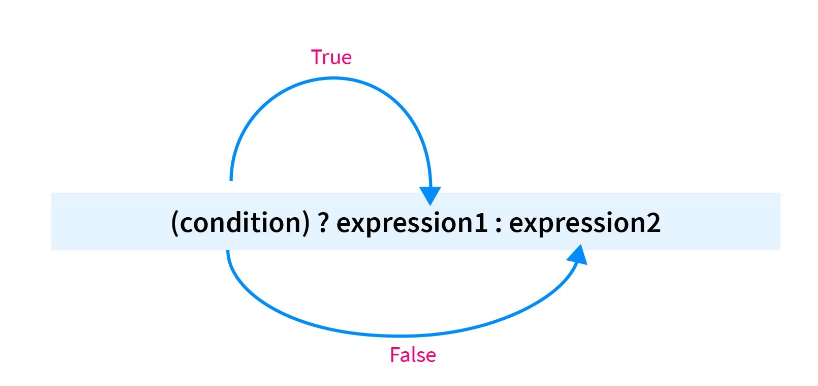
Example
Write a c program to demonstrate the conditional operator statement?
#include <stdio.h>
int main() {
int num;
scanf(“%d”, &num);
(num % 2 == 0)? printf(“The given number is even”) : printf(“The given number is odd”);
return 0;
}
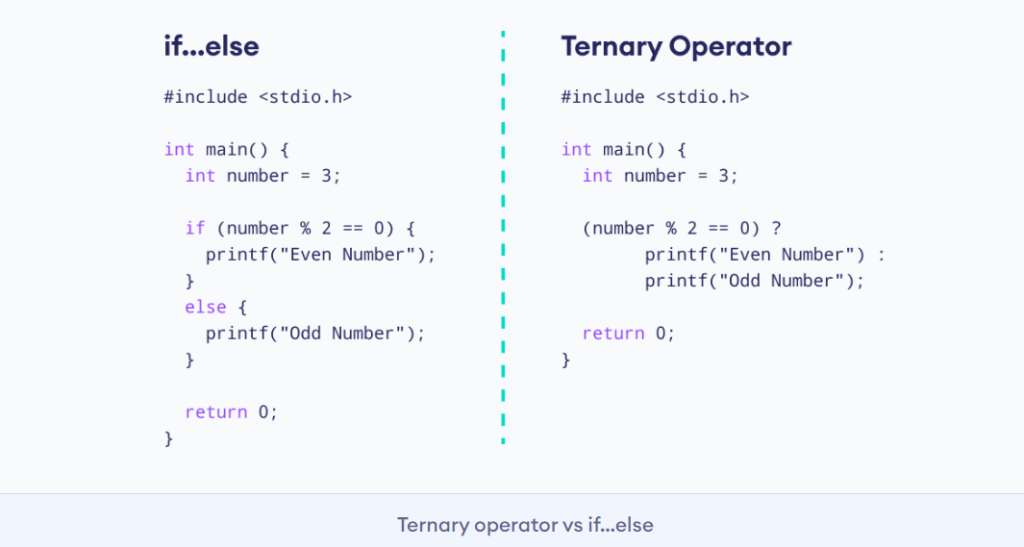
Questions for students:
- Write a c program to find greatest number among two numbers using conditional operator statement.
- Write a c program to print candidate can vote if candidate age is greater or equal to 18 and print candidate cannot vote if not greater than equal to age of 18.
2. Iteration / Looping statements:
Loop may be defined as block of statements which are repeatedly executed for a certain number of times or until a particular condition is satisfied. Iterations or loops are used when we want to execute a statement or block of statements several times. The repetition of loops is controlled with the help of a test condition. The statements in the loop keep on executing repetitively until the test condition becomes false.
There are three types of loop in C :
- While loop
- Do-while loop
- For loop
While loop: The while loop loops execute a block of code as long as a specified condition is true. It is also known as entry controlled loop that means the test condition is checked before entering the main body of the loop.
Syntax:
initialization_expression;
while (test_expression)
{
// body of the while loop
update_expression;
}
Example:
#include <stdio.h>
int main () {
/* local variable definition */
int a = 10;
/* while loop execution */
while( a < 20 ) {
printf(“value of a: %d\n”, a);
a++;
}
return 0;
}
Do-while loop: The do-while loop is similar to a while loop but the only difference lies in the do-while loop test condition which is tested at the end of the body. In the do-while loop, the loop body will execute at least once irrespective of the test condition. In case of do-while, firstly the statements inside the loop body are executed and then the condition is evaluated. As a result of which this loop is executed at least once even if the condition is initially false. After that the loop is repeated until the condition evaluates to false. Since in this loop the condition is tested after the execution of the loop, it is also known as posttest loop. It is also called exit controlled loop means the means the test condition is evaluated at the end of the loop body.
Syntax:
initialization_expression;
do
{
// body of do-while loop
update_expression;
} while (test_expression);
Example of Do while loop:
#include <stdio.h>
int main() {
int i = 0;
do {
printf(“%d\n”,i);
i++;
}while(i<=5);
return 0;
}

For loop: The for loop allows to execute block of statements for a number of times. when number of repetitions is known in advance, the use of for loop will be more efficient. Thus this loop is also known as a determinate or definite loop. For loop consists of three expressions with semicolons.
for(initialization; test_condition; increment or decrement) { Statements or body of loop; }
Example: Write a program to write a table of n number given by user.
#include<stdio.h>
int main(){
int i=1,number;
printf(“Enter a number: “);
scanf(“%d”,&number);
for(i=1;i<=10;i++){
printf(“%d \n”,(number*i));
}
return 0;
}
/* C program to calculate a Factorial of a given number */
#include <stdio.h>
int main()
{
int num,i;
long fact=1;
printf(“Enter number”);
scanf(“%d”,&num);
for(i=1;i<=num;i++)
fact=fact*i;
printf(“%ld”,fact);
return 0;
}
C program to generate Fibonaci series (most important, will apear in exam question)
#include <stdio.h>
int main() {
int i, n;
// initialize first and second terms
int t1 = 0, t2 = 1;
// initialize the next term (3rd term)
int nextTerm = t1 + t2;
// get no. of terms from user
printf(“Enter the number of terms: “);
scanf(“%d”, &n);
// print the first two terms t1 and t2
printf(“Fibonacci Series: %d, %d, “, t1, t2);
// print 3rd to nth terms
for (i = 3; i <= n; ++i) {
printf(“%d, “, nextTerm);
t1 = t2;
t2 = nextTerm;
nextTerm = t1 + t2;
}
return 0;
}
Nested Loop
Nested loop: Using a loop inside another loop is called nested loop. C support n times of nested loop. The nested for loop means any type of loop which is defined inside the ‘for’ loop.
Syntax of Nested loop
Outer_loop
{
Inner_loop
{
// inner loop statements.
}
// outer loop statements.
}
Example of nested loop to print pattern:
*
**
***
****
*****
#include <stdio.h>
int main() {
int i, j, n;
// Ask the user for the number of rows
printf(“Enter the number of rows: “);
scanf(“%d”, &n);
// Outer loop for rows
for (i = 1; i <= n; i++) {
// Inner loop for columns (stars in each row)
for (j = 1; j <= i; j++) {
printf(“*”);
}
// Move to the next line after each row
printf(“\n”);
}
return 0;
}
2. Example of nested for loop
#include <stdio.h>
int main()
{
int n;// variable declaration
printf(“Enter the value of n :”);
scanf(“%d”,&n);
// Displaying the n tables.
for(int i=1;i<=n;i++) // outer loop
{
for(int j=1;j<=10;j++) // inner loop
{
printf(“%d\t”,(i*j)); // printing the value.
}
printf(“\n”);
}
Explanation of the above code
- First, the ‘i’ variable is initialized to 1 and then program control passes to the
i<=n. - The program control checks whether the condition ‘i<=n’ is true or not.
- If the condition is true, then the program control passes to the inner loop.
- The inner loop will get executed until the condition is true.
- After the execution of the inner loop, the control moves back to the update of
the outer loop, i.e., i++. - After incrementing the value of the loop counter, the condition is checked again,
i.e., i<=n. - If the condition is true, then the inner loop will be executed again.
- This process will continue until the condition of the outer loop is true.
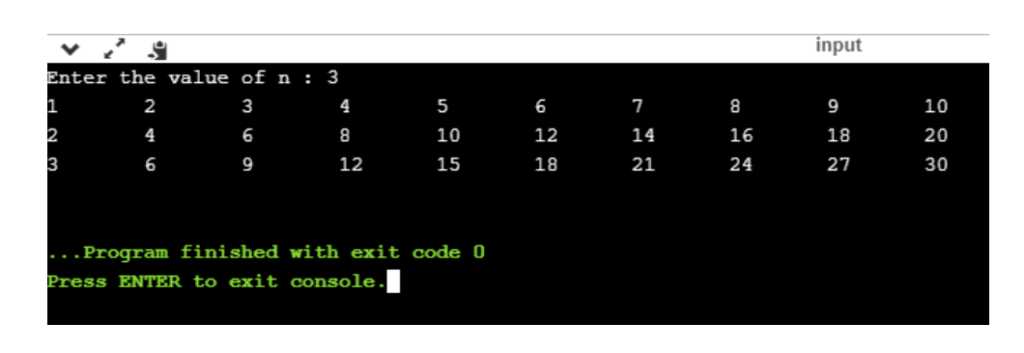
3. Jump Statements / Loop Interrupts
In C, you can control the flow of loops using loop interrupts such as break, continue, and return. These keywords allow you to alter the normal flow of control within loops and functions.
Jump statements in C are used to alter the normal sequence of execution of a program. They allow the program to transfer control to a different part of the code.
Simple definition: Jump statements are used to transfer the control from one part of the program to another part.
Types of Jump Statements in C
There are four types of jump statements:
- break
- continue
- goto
- return
The break Statement terminates the execution of the loop and the control transferred to the statement immediately following the loop.
Break statement is used inside the loops or switch statement. This statement causes an immediate exit from the loop or the switch case block in which it appears. If the test condition is to be terminated instantly without testing termination condition, the break statement is useful.
It can be written as
break;
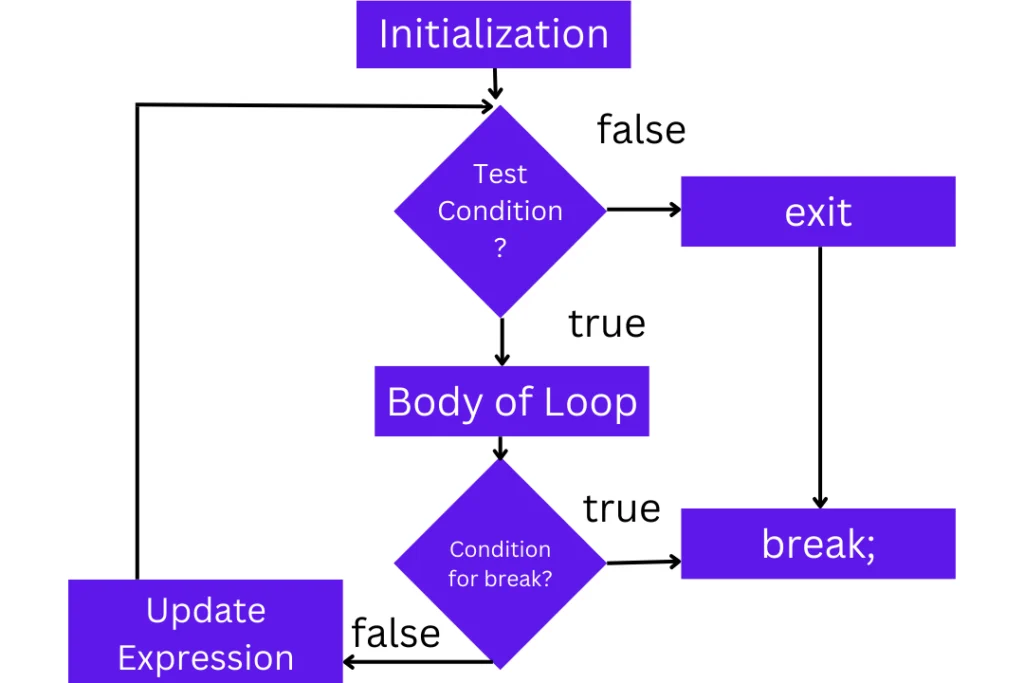
Simple Progam example of break statement:
#include<stdio.h>
#include<conio.h>
int main()
{
int i;
for(i=1; i<10; i++)
{
printf(“%d”, i);
if(i==5)
break;
}
getch();
Output:
1 2 3 4 5
Continue statement
goto statement
Function
A function is a block of code that performs a specific task when it is called.
The function is also known as procedureor subroutine in other programming languages. Function enable us to write code separately for different functions.
Syntax:
return_type function_name( parameter list )
{
body of the function
}
Types of function
There are two types of function in C programming:
- Standard library functions
- User-defined functions
Standard library functions: Library functions are predefined / built in functions.
For example: printf(), scanf();, getch(), sqrt(), etc. These functions are defined in header files.
User Defined functions: Those functions that are created by user as per his/her need. Such Functions are known as User Defined functions.
Function prototype, Definition, and call
- Function prototype is also called funciton declaration. Function declaration is done above of the main function. Passing arguments in the function declaration and function definition are formal parameters which copied the values from actual parameters. Formal parameters are always in variables.
- Function Definition is a block of code that define the specific task that are enclosed with { }.
- Function call is done inside the main function. Passing the arguments while calling function is actual parameters. Actual parameters can be both values or variables.
Define actual and formal parameters?
Actual and formal parameters are two different forms of parameters that we use while declaring, defining and invoking a function. The actual parameter is the one that we pass to a function when we invoke it. On the other hand, a formal parameter is one that we pass to a function when we declare and define it.
| BASIS FOR COMPARISON | ACTUAL PARAMETER | FORMAL PARAMETER |
|---|---|---|
| Definition | They are actual values passed to a function on which the function will perform operations | They are the variables in the function definition that would receive the values when the function is invoked |
| Occurrence | It occurs when we invoke a function | It occurs when we declare and define a function |
| Provided by | Either by the programmer or by the user | Only by programmer |
| Data types | Data types are not mentioned with the actual parameters | Data types are mentioned along the formal parameters |
| Form | It can be a value or a variable | It is always a variable |
| Example | add (a, b); | int add (int x, int y) { //body } |
Different Ways of Calling a Function:
Depending on whether the function accepts arguments or not and returns a value or not, there can be four different aspects of C function calls, which are://Example of function with arugments and with return
#include<stdio.h>
int greater();
int greater( int a, int b)
{
if(a>b)
return a;
else
return b;
}
int main()
{
int a,b,c;
printf(“enter a and b:”);
scanf(“%d%d”,&a,&b);
c=greater(a,b); //
printf(“greater is %d”,c);
return 0;
}
To Perform sum
//Example of function with arugments and with return
#include<stdio.h>
int sum(int int);
int sum(int x, int y)
{
int z=x+y;
return z;
}
int main()
{
int a,b,s;
printf(“enter two number\n:”);
scanf(“%d%d”, &a, &b);
s=sum(a,b);
prinftf(“%d is sum”, s);
return o;
}
#include<stdio.h>
void sum(int int);
void sum(int x, int y)
{
int s;
s=x+y;
printf(“sum is %d”,s);
}
int main()
{
int a,b,s;
printf(“enter two number\n:”);
scanf(“%d%d”, &a, &b);
s=sum(a,b);
return o;
}
There are two methods to pass the data into the function in C language, i.e., call by value and call by reference.
HOW TO CALL C FUNCTIONS IN A PROGRAM?
1. Call by value
2. Call by reference
1. CALL BY VALUE:
In call by value method, the value of the variable is passed to the function as parameter.
The value of the actual parameter can not be modified by formal parameter.
Different Memory is allocated for both actual and formal parameters. Because, value of actual parameter is copied to formal parameter.
Note:
Actual parameter – This is the argument which is used in function call.
Formal parameter – This is the argument which is used in function definition
EXAMPLE PROGRAM FOR C FUNCTION (USING CALL BY VALUE):
In this program, the values of the variables “m” and “n” are passed to the function “swap”.
These values are copied to formal parameters “a” and “b” in swap function and used.
#include<stdio.h>
// function prototype, also called function declaration
void swap(int a, int b);
int main()
{
int m = 22, n = 44;
// calling swap function by value
printf(” values before swap m = %d \nand n = %d”, m, n);
swap(m, n);
}
void swap(int a, int b)
{
int tmp;
tmp = a;
a = b;
b = tmp;
printf(” \nvalues after swap m = %d\n and n = %d”, a, b);
}
2. CALL BY REFERENCE:
In call by reference method, the address of the variable is passed to the function as parameter.
The value of the actual parameter can be modified by formal parameter.
Same memory is used for both actual and formal parameters since only address is used by both
parameters.
EXAMPLE PROGRAM FOR C FUNCTION (USING CALL BY REFERENCE):
In this program, the address of the variables “m” and “n” are passed to the function “swap”.
These values are not copied to formal parameters “a” and “b” in swap function.
Because, they are just holding the address of those variables.
This address is used to access and change the values of the variables.
#include<stdio.h>
// function prototype, also called function declaration
void swap(int *a, int *b);
int main()
{
int m = 22, n = 44;
// calling swap function by reference
printf(“values before swap m = %d \n and n = %d”,m,n);
swap(&m, &n);
}
void swap(int *a, int *b)
{
int tmp;
tmp = *a;
*a = *b;
*b = tmp;
printf(“\n values after swap a = %d \nand b = %d”, *a, *b);
}
| No. | Call by value | Call by reference |
|---|---|---|
| 1 | A copy of the value is passed into the function | An address of value is passed into the function |
| 2 | Changes made inside the function is limited to the function only. The values of the actual parameters do not change by changing the formal parameters. | Changes made inside the function validate outside of the function also. The values of the actual parameters do change by changing the formal parameters. |
| 3 | Actual and formal arguments are created at the different memory location | Actual and formal arguments are created at the same memory location |
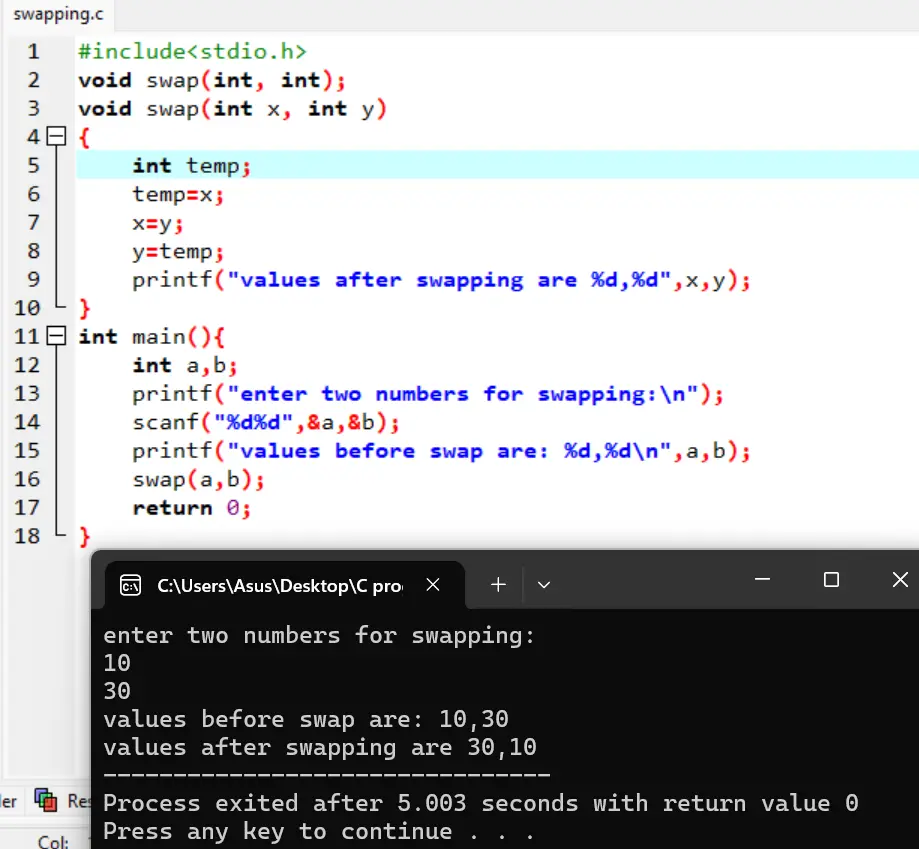
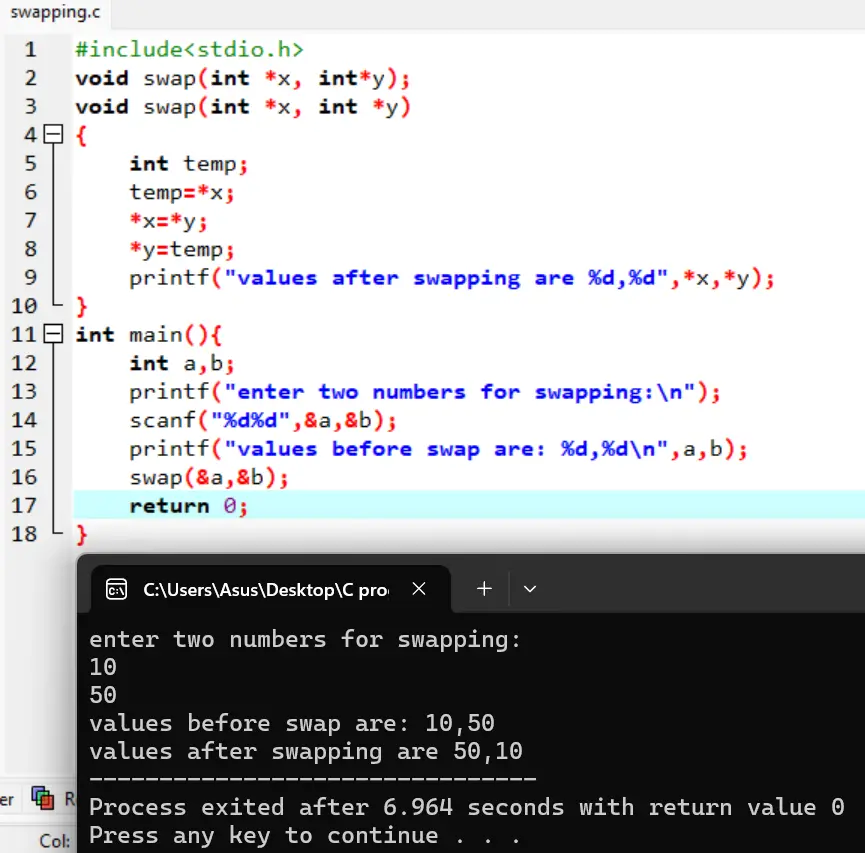
Recursion
Function that call itself is called recursion. While using recursion, programmers need to be careful to define an exit condition from the function, otherwise it will go into an infinte loop.
Syntax:
void recursion() {
recursion(); /* function calls itself */
}
int main()
{
recursion();
}
//Example of recursion function to find n terms of ficonacci series
#include <stdio.h>
int fibonacci(int); // function declaration
//function definition section start
int fibonacci(int x) {
if(x == 0) {
return 0;
}
if(x == 1) {
return 1;
}
else
return fibonacci(x-1) + fibonacci(x-2); //function call itself
}
//main function section start
int main() {
int a;
printf(“enter a number:”);
scanf(“%d”,&a);
int y;
for (y = 0; y < a; y++) {
printf(“%d\n”, fibonacci(y));
}
return 0;
}
Unit-5 Array, Pointer String
Array:
An array is a collection of values of similar kinds of data types. Values in array accessed using array name with subscripts in brackets[]. Syntax of array declaration is:
data_type array_name[size];
Declaration and initialization of array
An array is a variable that can store multiple values. For example, if you want to store 100 integers, you can create an array for it.
dataTypearrayName[arraySize];
int data[100];
It is possible to initialize an array during declaration. For example,
int mark[5] = {19, 10, 8, 17, 9};
You can also initialize an array like this.
int mark[] = {19, 10, 8, 17, 9};
Accessing array
Array can be accessed using array-name and subscript variable written inside pair of square brackets [].
for example:
arr[3] = Third Element of Array
arr[5] = Fifth Element of Array
arr[8] = Eighth Element of Array
// Program to take 5 values from the user and store them in an array
// Print the elements stored in the array
#include <stdio.h>
int main()
{
int i, array[5];
printf(“Enter 5 integers: “);
// taking input and storing it in an array
for(i = 0; i < 5; i++)
{
scanf(“%d”, &array[i]);
}
printf(“printing those values: “);
// printing elements of an array
for( i = 0; i < 5; ++i)
{
printf(“%d\n”, array[i]);
}
return 0;
}
//C Program to find smallest element in an array
#include<stdio.h>
int main() {
int a[30], i, num, smallest;
printf(“\nEnter no of elements :”);
scanf(“%d”, &num); //Read n elements in an array
for (i = 0; i < num; i++)
scanf(“%d”, &a[i]); //Consider first element as smallest
smallest = a[0];
for (i = 0; i < num; i++) {
if (a[i] < smallest) {
smallest = a[i]; } } // Print out the Result
printf(“\nSmallest Element : %d”, smallest);
return (0);
}
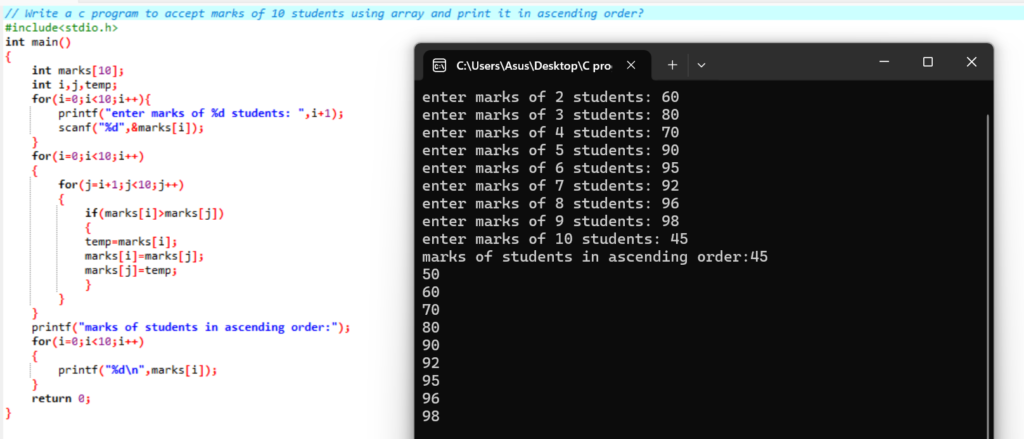
Multidimensional Arrays: An array with more than one index value is called a multidimensional array. Syntax to declare a multidimensional array:
data_type array_name[][][]…;
write a c program to add 2*2 two matrices ?
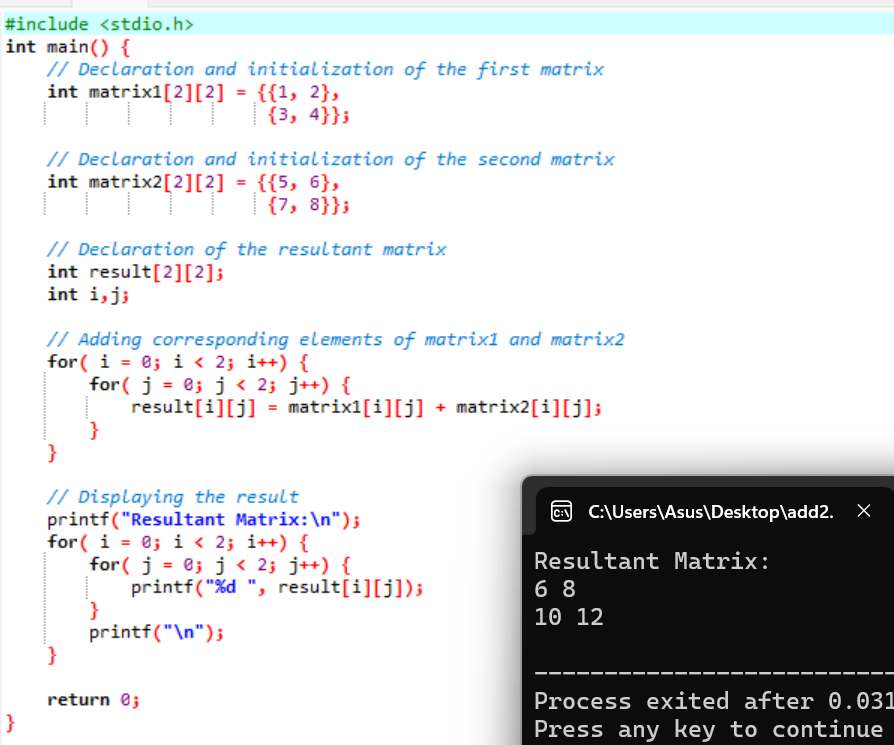
C program to add two 2x2 matrices based on user input ?
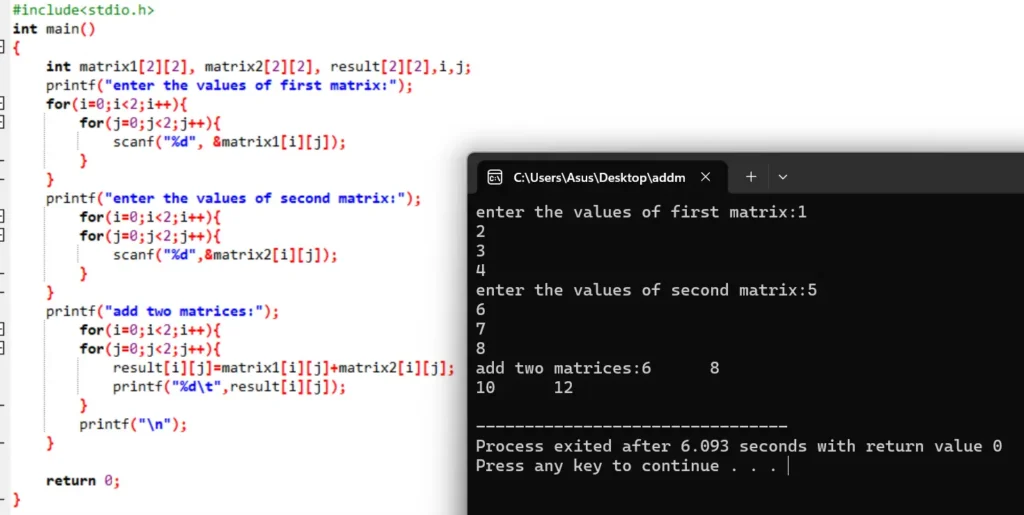
c program to multiply 3*3 matrices by taking matrix values from user input.
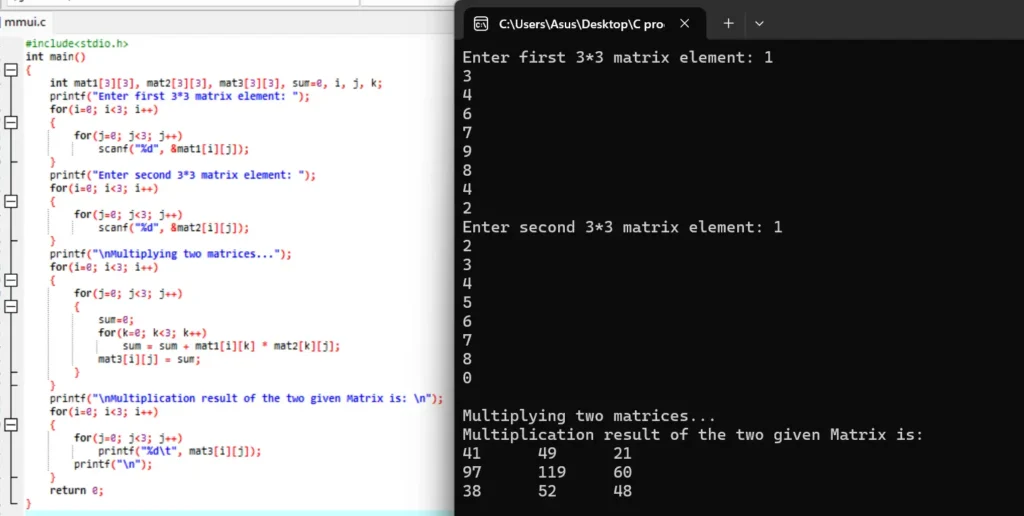
Write a c program to implement 2*3 Matrix Multiplication?
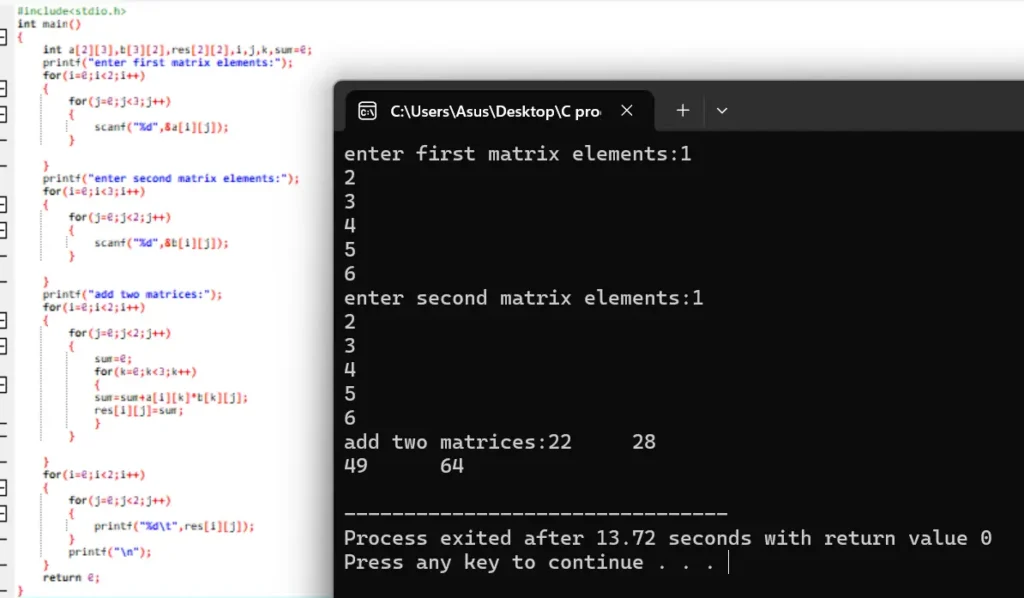
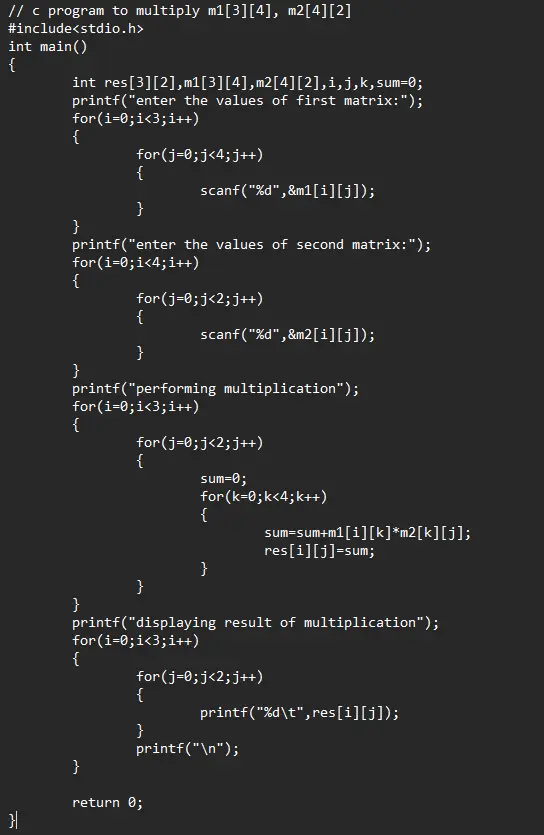
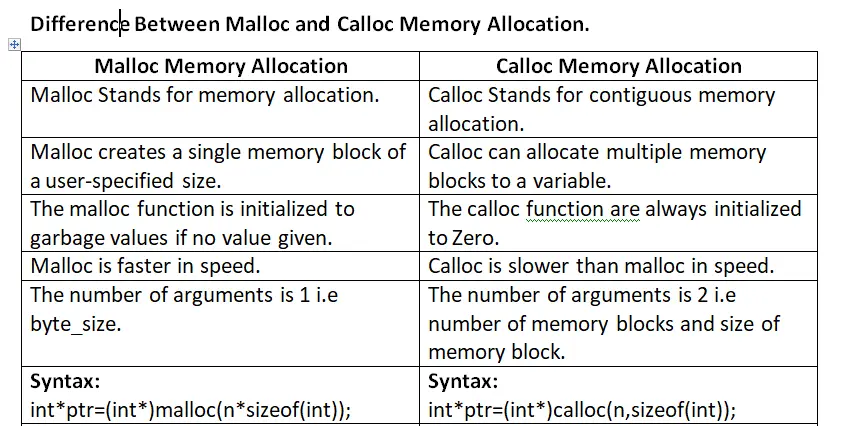
#include <stdio.h>
#include <stdlib.h>
int main() {
int *num1, *num2, *sum;
// Allocating memory for integers using malloc
num1 = (int*) malloc(sizeof(int));
num2 = (int*) malloc(sizeof(int));
sum = (int*) malloc(sizeof(int));
if (num1 == NULL || num2 == NULL || sum == NULL) {
printf(“Memory allocation failed!\n”);
return 1;
}
// Input numbers
printf(“Enter first number: “);
scanf(“%d”, num1);
printf(“Enter second number: “);
scanf(“%d”, num2);
// Perform addition
*sum = *num1 + *num2;
// Display result
printf(“Sum: %d\n”, *sum);
// Free allocated memory
free(num1);
free(num2);
free(sum);
return 0;
}
Concept of Pointer, pointer address, dereference, declaration,assignment, intializaion
Pointer
A pointer is a variable that stores the memory address of another variable as its value. Pointer variable is always preceded by * operator.
if a pointer variable p is declared as : int *p;
it signifies p is pointer variable and it can store address of integer variable (i.e. it can not store address of other type’s variables.
* operator is deference operator
& operator is reference operator
An indirection operator, is an operator used to obtain the value of a variable to which a pointer points. While a pointer pointing to a variable provides an indirect access to the value of the variable stored in its memory address, the indirection operator dereferences the pointer and returns the value of the variable at that memory location. The indirection operator is a unary operator represented by the symbol (*). The indirection operator is also known as the dereference operator.
Valid Examples:
int *p;
int num;
p=#
Invalid Examples:
int *p;
float num;
p=# /* invalid pointer variable p cannot store address of float variable */
Pointer Declaration
A pointer variable is declared as follows:
Syntax:
data_type * variable_name;
here, *is called indirection or dereference operator and variable_name is now pointer.
Example:
int *x;
float *y;
char *rajesh;
Write a c program to add to numbers using Pointer

Pointer Arithmetic
Pointer Arithmetic refers to arithmetic operations on pointers. Since pointers store memory addresses, Pointer Arithmetic operations help navigate through memory locations efficiently.
1. Types of Pointer Arithmetic
You can perform the following operations with pointers in C:
- Increment (
ptr++) – Moves to the next memory location. - Decrement (
ptr--) – Moves to the previous memory location. - Addition (
ptr + n) – Movesnpositions forward. - Subtraction (
ptr - n) – Movesnpositions backward. - Pointer difference (
ptr2 - ptr1) – Finds the number of elements between two pointers.
1:Pointer Increment & Decrement
#include <stdio.h>
int main() {
int arr[] = {10, 20, 30, 40, 50};
int *ptr = arr; // Pointer to the first element
printf(“Initial pointer value: %d\n”, *ptr);
ptr++; // Move to the next element
printf(“After increment: %d\n”, *ptr);
ptr–; // Move back to the first element
printf(“After decrement: %d\n”, *ptr);
return 0;
}
Output:
Initial pointer value: 10
After increment: 20
After decrement: 10
2: Pointer Addition and Subtraction
#include <stdio.h>
int main() {
int arr[] = {5, 10, 15, 20, 25};
int *ptr = arr; // Pointer to the first element
printf(“Value at ptr: %d\n”, *ptr);
ptr = ptr + 2; // Move two positions forward
printf(“After ptr + 2: %d\n”, *ptr);
ptr = ptr – 1; // Move one position backward
printf(“After ptr – 1: %d\n”, *ptr);
return 0;
}
#include <stdio.h>
int main() {
int num = 10;
int *ptr = # // Pointer pointing to num
printf(“Address of num: %p\n”, ptr);
ptr = ptr + 1; // Move the pointer forward by 1 int (4 bytes)
printf(“Address after addition: %p\n”, ptr);
ptr = ptr – 1; // Move the pointer back to original position
printf(“Address after subtraction: %p\n”, ptr);
return 0;
}
STRINGS:
An array of characters are known as Strings. There are various built-in string handling functions in c. Some of them are:
- strcpy()
- strcat()
- strcmp()
- strcmpi()
- strupr()
- strlwr()
- strrev()
#include <stdio.h>
#include <string.h> // Required for string handling functions
// Main function
int main() {
// Declare string variables
char str1[50] = “Hello”;
char str2[50] = ” World”;
char str3[50];
// strcpy: Copying string
strcpy(str3, str1); // Copy content of str1 into str3
printf(“After strcpy, str3: %s\n”, str3); // Output: Hello
// strcat: Concatenate strings
strcat(str1, str2); // Concatenate str2 to str1
printf(“After strcat, str1: %s\n”, str1); // Output: Hello World
// strlen: Find the length of a string
int len = strlen(str1); // Get the length of str1
printf(“Length of str1: %d\n”, len); // Output: 12
// strupr: Convert string to uppercase
strupr(str1); // Convert str1 to uppercase
printf(“After strupr, str1: %s\n”, str1); // Output: HELLO WORLD
// strlwr: Convert string to lowercase
strlwr(str1); // Convert str1 back to lowercase
printf(“After strlwr, str1: %s\n”, str1); // Output: hello world
// strrev: Reverse the string
strrev(str1); // Reverse str1
printf(“After strrev, str1: %s\n”, str1); // Output: dlrow olleh
return 0;
}
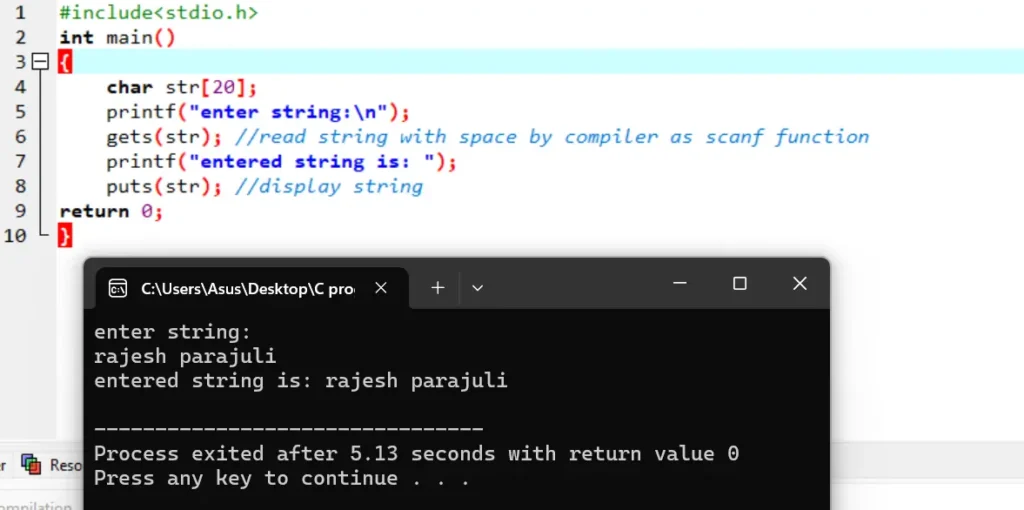
Structure:
The structure is the collection of different data types grouped under the same name using the struct keyword. It is also known as the user-defined data type that enables the programmer to store different data type records in the Structure. Furthermore, the collection of data elements inside the Structure is termed as the member.
#include<stdio.h>
#include<string.h> // Include this header for strcpy
struct student
{
int id;
char name[30];
char gender[30];
int age;
};
int main() {
struct student st;
st.id = 1;
// Use strcpy to assign string values to character arrays
strcpy(st.name, “rajesh”);
strcpy(st.gender, “male”);
st.age = 28;
// Print the struct values
printf(“id is %d\n”, st.id);
printf(“name is %s\n”, st.name);
printf(“gender is %s\n”, st.gender);
printf(“age is %d\n”, st.age);
return 0;
}
Simple c program using structure:
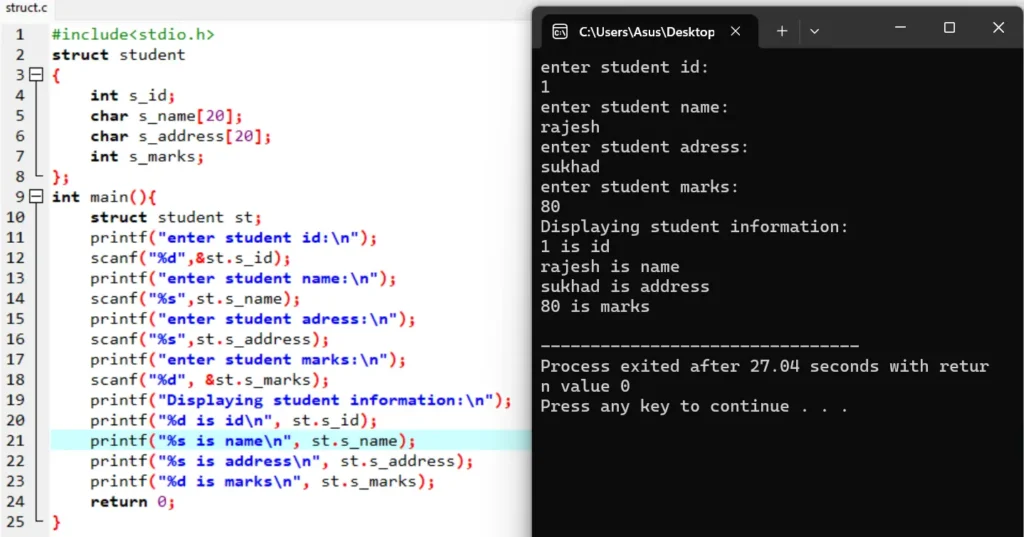
Write a c program to store information of 5 employee(empid, name, salary) and display it using structure variable. (Most Important for Exam +2, BCA, BICTE)
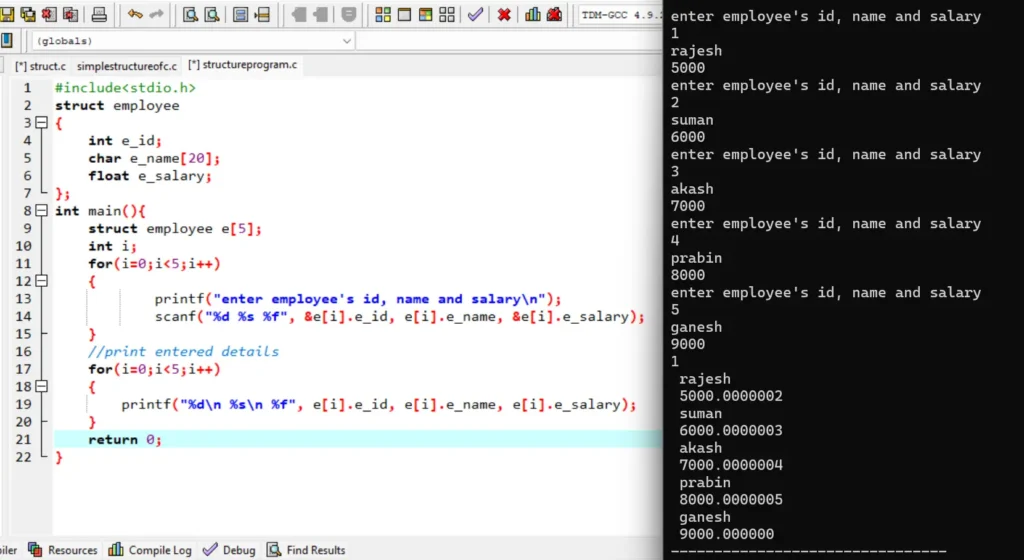
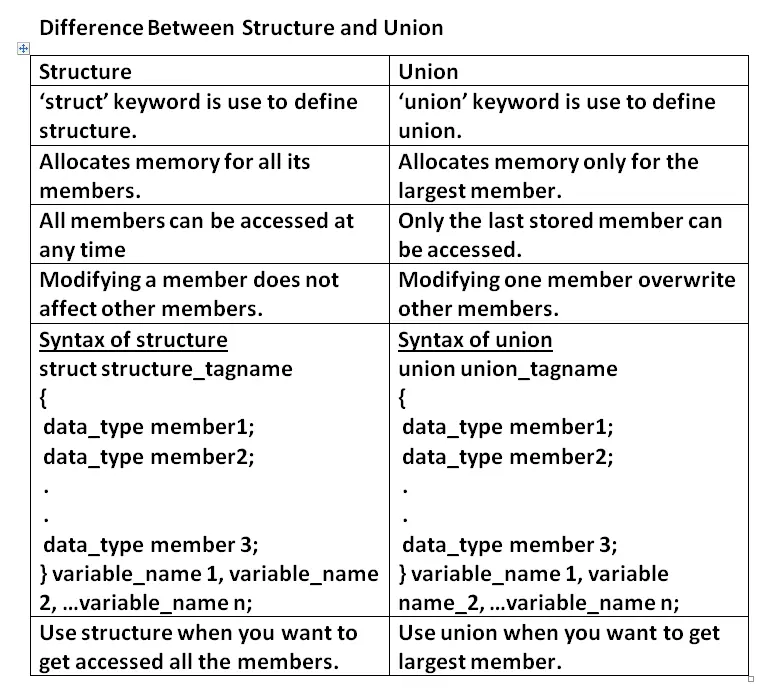
Structure pointer
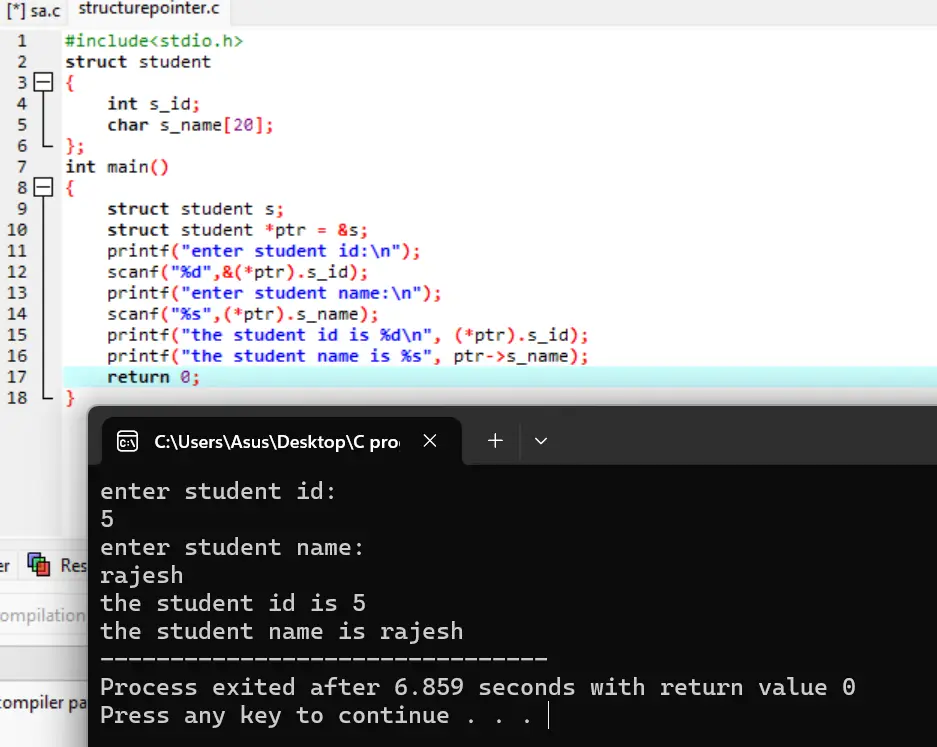
File Hanndling in C
A file is a collection of sequence of bytes(data) in one unit on the disk permanently. In general, file is a collection of related records such as student’s name, date of birth, address, marks, phone number etc. Various operations can be done such as creating a file, opening a file, reading, writing, moving to a specific location in a file, and closing a file.
File handling is the process of storing data in the form of input or output produced by running C programs in data file for future reference and analysis. File handling provides a mechanism to store the output of a program in a file and to perform various operations on it.
File handling concept provides various operations like creating a file, opening a file, reading a file or manipulating data inside a file etc.
Why file handling?
The data stored in the various of a program will be lost once the program is terminated because they are stored in the Random Access Memory(RAM) which is volatile memory. So, if we want store that data(input/output) used in the program permanently inside the secondary storage device so that, we can access these data from there whenever it is needed file handling concept is important.
File handling in C enables us to create, update, read, and delete the files stored on the local file system through our C program. Some operations can be performed on a file.
- Creation of the new file
- Opening an existing file
- Reading from the file
- Writing to the file
- Deleting the file
C provides a number of build-in function to perform basic file operations:
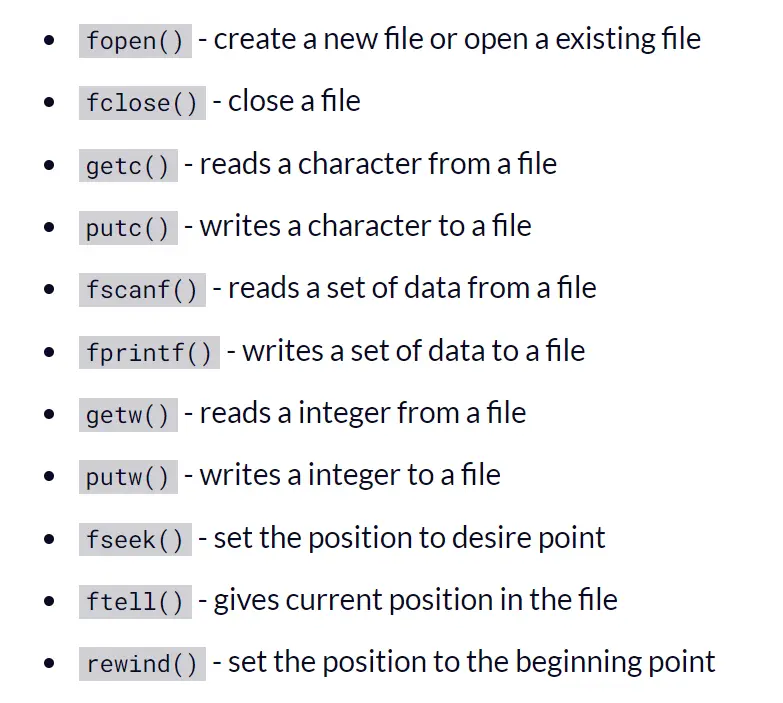
Various File opening modes in c
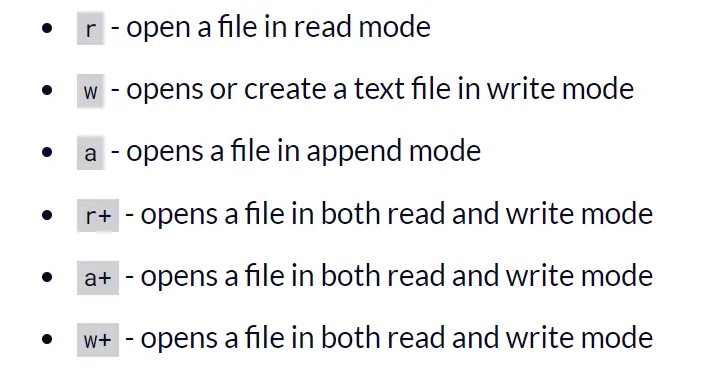
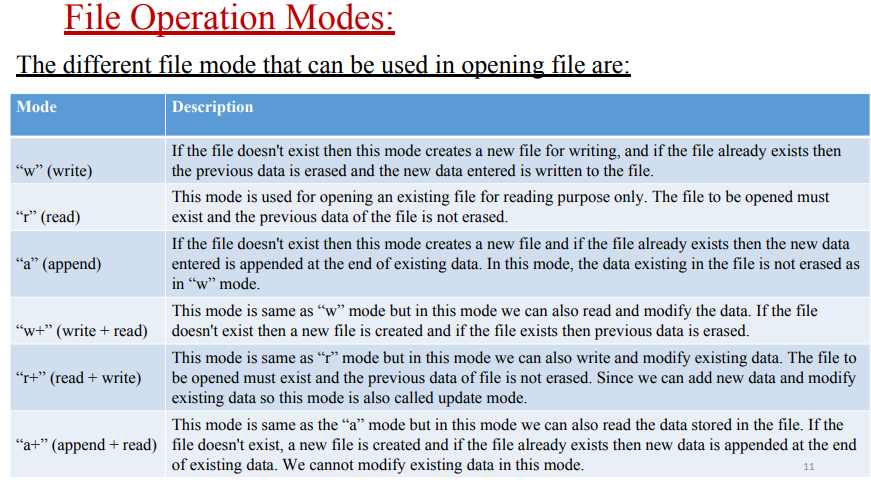
Creating a file in c

Write a c program to write name, roll no and marks of students in file using fprintf function.
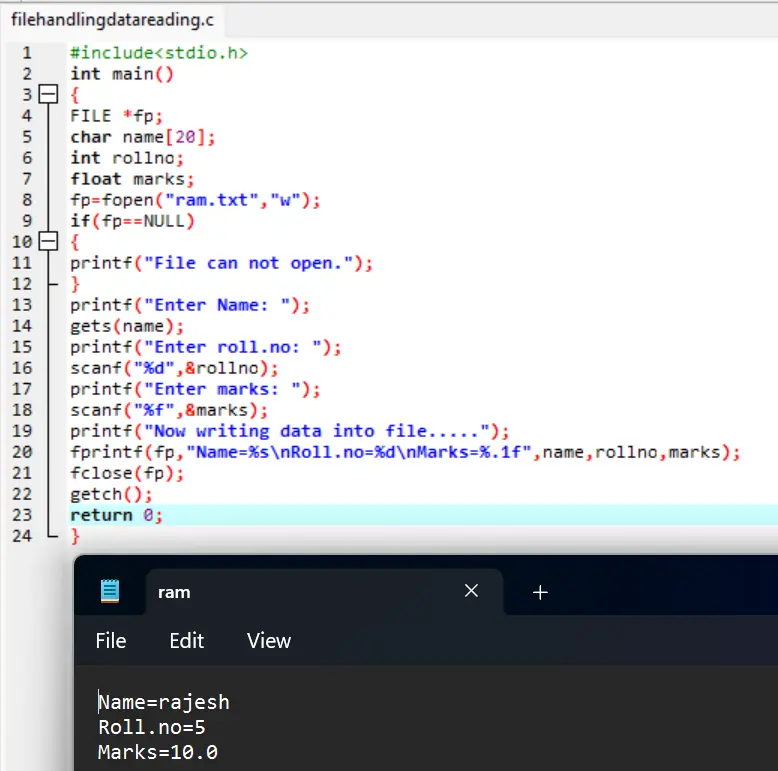
Write a c program to store Id, and name of 5 students in file. (Most important for +2, BCA, BICTE, BIT)
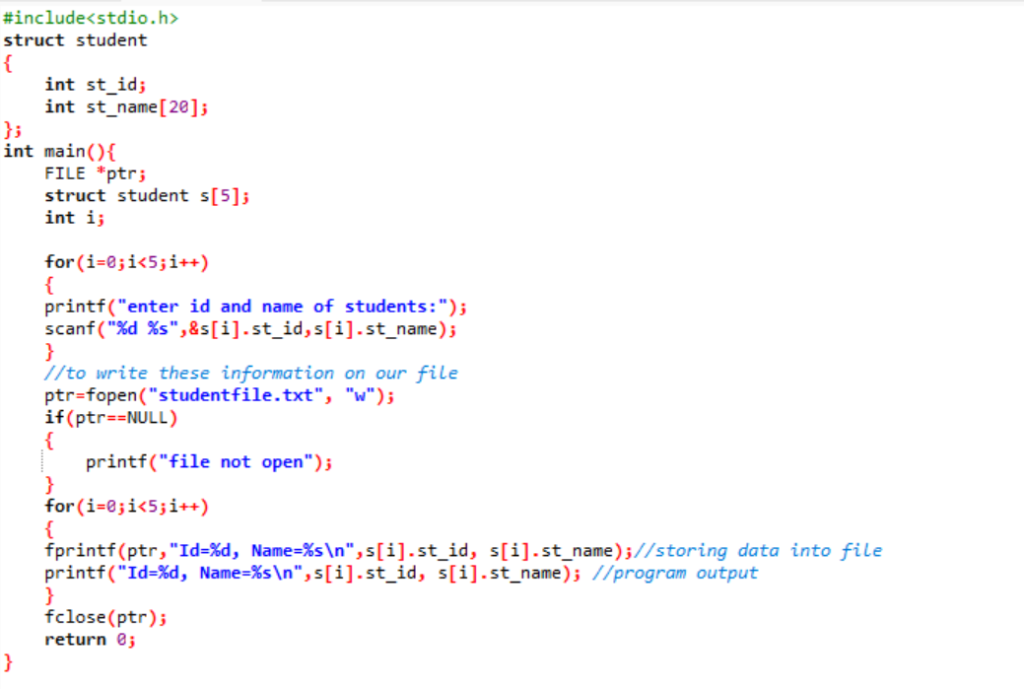

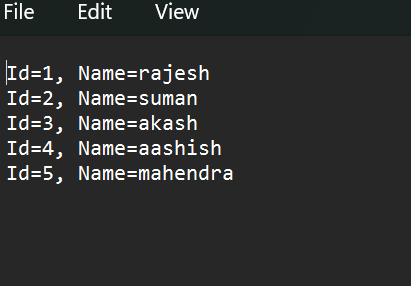
Formatted input output in file handling in c
Formatted Input and Output in File Handling (C) In C, file handling functions can also support formatted input and output, just like printf() and scanf() work for standard input and output. For files, we use fprintf() and fscanf() for formatted writing and reading, respectively.
fprintf()is used to write formatted data to the file.fscanf()is used to read formatted data from the file.- fprintf(file, “Age: %d\n”, age);
- fscanf(file, “Age: %d\n”, &age);
#include <stdio.h>
int main() {
FILE *file;
int age = 30;
float salary = 55000.50;
// Open file for writing
file = fopen(“formatted_data.txt”, “w”);
if (file == NULL) {
printf(“Error opening file for writing.\n”);
return 1;
}
// Write formatted data to the file
fprintf(file, “Age: %d\n”, age);
fprintf(file, “Salary: %.2f\n”, salary);
// Close the file after writing
fclose(file);
// Open file for reading
file = fopen(“formatted_data.txt”, “r”);
if (file == NULL) {
printf(“Error opening file for reading.\n”);
return 1;
}
// Read formatted data from the file
int read_age;
float read_salary;
fscanf(file, “Age: %d\n”, &read_age);
fscanf(file, “Salary: %f\n”, &read_salary);
// Print the read data
printf(“Data read from file:\n”);
printf(“Age: %d\n”, read_age);
printf(“Salary: %.2f\n”, read_salary);
// Close the file after reading
fclose(file);
return 0;
}
File Handling Errors: When working with files, always check if a file is successfully opened. If fopen() returns NULL, the file couldn’t be opened.
Example:
FILE *file = fopen(“example.txt”, “r”);
if (file == NULL) {
printf(“Unable to open a file.\n”);
return 1; // Exit program with an error code
}
Basic File Operations in C
In C, file operations are done using the stdio.h library.
1. Opening a File (fopen): To open a file, use the fopen() function. You need to specify the file name and mode (r, w, a, etc.).
Example:
FILE *fopen(“xyz.txt”, “r”); //where xyz.txt is file and r is reading mode of the file
modes:
r: Read (file must exist)
w: Write (create file or overwrite)
a: Append (add data at the end)
2. Writing to a File (fprintf, fputs): To write data to a file, use fprintf() or fputs().
3. Reading from a File (fscanf, fgets): To read from a file, use fscanf() or fgets().
4. Closing a File (fclose)
